15.2 Introduction to the Digestive System

We All Scream for Ice Cream
If you’re an ice cream lover, then just the sight of this yummy ice cream cone may make your mouth water. The “water” in your mouth is actually saliva, a fluid released by glands that are part of the digestive system. Saliva contains digestive enzymes, among other substances important for digestion. When your mouth waters at the sight of a tasty treat, it’s a sign that your digestive system is preparing to digest food.
What Is the Digestive System?
The digestive system consists of organs that break down food, absorb its nutrients, and expel any remaining waste. Organs of the digestive system are shown in Figure 15.2.2. Most of these organs make up the gastrointestinal (GI) tract, through which food actually passes. The rest of the organs of the digestive system are called accessory organs. These organs secrete enzymes and other substances into the GI tract, but food does not actually pass through them.
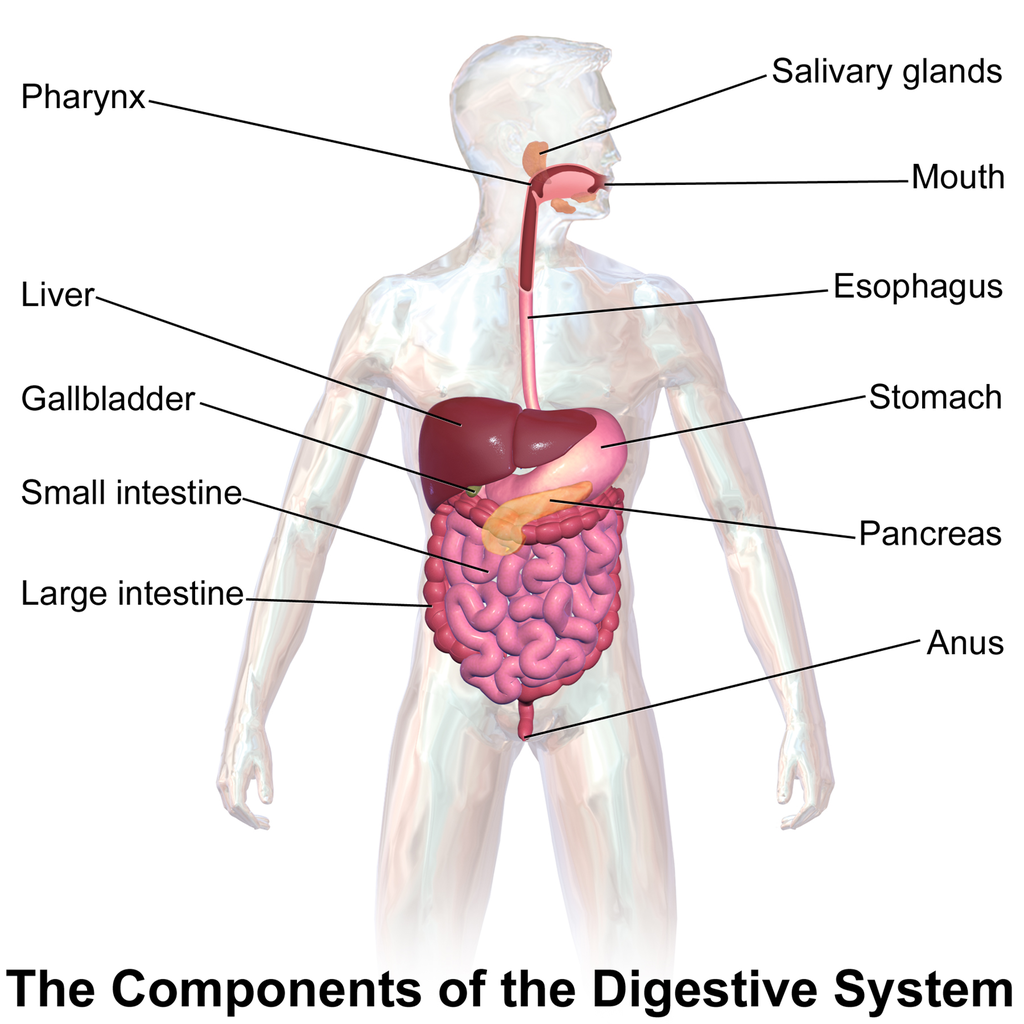
Functions of the Digestive System
The digestive system has three main functions relating to food: digestion of food, absorption of nutrients from food, and elimination of solid food waste. Digestion is the process of breaking down food into components the body can absorb. It consists of two types of processes: mechanical digestion and chemical digestion. Mechanical digestion is the physical breakdown of chunks of food into smaller pieces, and it takes place mainly in the mouth and stomach. Chemical digestion is the chemical breakdown of large, complex food molecules into smaller, simpler nutrient molecules that can be absorbed by body fluids (blood or lymph). This type of digestion begins in the mouth and continues in the stomach, but occurs mainly in the small intestine.
After food is digested, the resulting nutrients are absorbed. Absorption is the process in which substances pass into the bloodstream or lymph system to circulate throughout the body. Absorption of nutrients occurs mainly in the small intestine. Any remaining matter from food that is not digested and absorbed passes out of the body through the anus in the process of elimination.
Gastrointestinal Tract
The gastrointestinal (GI) tract is basically a long, continuous tube that connects the mouth with the anus. If it were fully extended, it would be about nine metres long in adults. It includes the mouth, pharynx, esophagus, stomach, and small and large intestines. Food enters the mouth, and then passes through the other organs of the GI tract, where it is digested and/or absorbed. Finally, any remaining food waste leaves the body through the anus at the end of the large intestine. It takes up to 50 hours for food or food waste to make the complete trip through the GI tract.
Tissues of the GI Tract
The walls of the organs of the GI tract consist of four different tissue layers, which are illustrated in Figure 15.2.3: mucosa, submucosa, muscularis externa, and serosa.
- The mucosa is the innermost layer surrounding the lumen (open space within the organs of the GI tract). This layer consists mainly of epithelium with the capacity to secrete and absorb substances. The epithelium can secret digestive enzymes and mucus, and it can absorb nutrients and water.
- The submucosa layer consists of connective tissue that contains blood and lymph vessels, as well as nerves. The vessels are needed to absorb and carry away nutrients after food is digested, and nerves help control the muscles of the GI tract organs.
- The muscularis externa layer contains two types of smooth muscle: longitudinal muscle and circular muscle. Longitudinal muscle runs the length of the GI tract organs, and circular muscle encircles the organs. Both types of muscles contract to keep food moving through the tract by the process of peristalsis, which is described below.
- The serosa layer is the outermost layer of the walls of GI tract organs. This is a thin layer that consists of connective tissue and separates the organs from surrounding cavities and tissues.
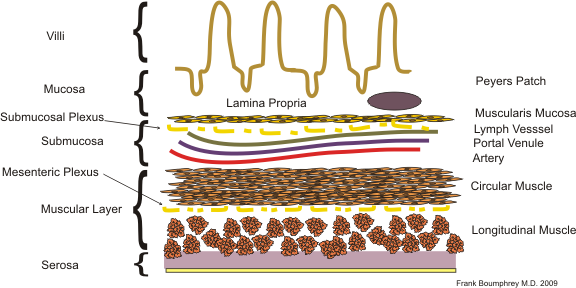 |
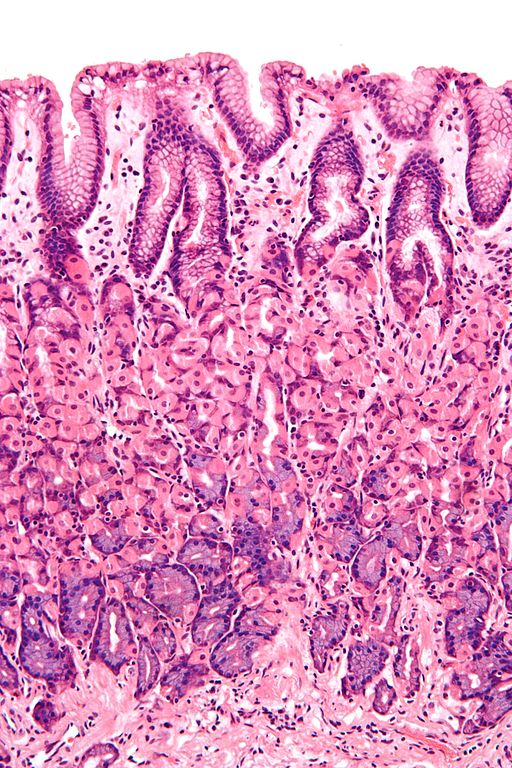 |
Peristalisis in the GI Tract
The muscles in the walls of GI tract organs enable peristalsis, which is illustrated in Figure 15.2.5. Peristalsis is a continuous sequence of involuntary muscle contraction and relaxation that moves rapidly along an organ like a wave, similar to the way a wave moves through a spring toy. Peristalsis in organs of the GI tract propels food through the tract.
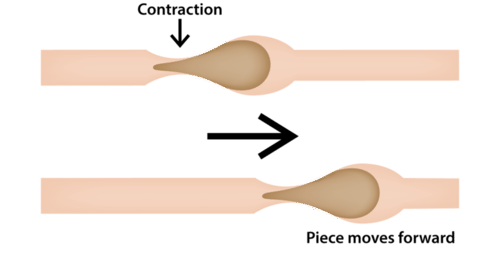
Watch the video “What is peristalsis?” by Mister Science to see peristalsis in action:
What is peristalsis?, Mister Science, 2018.
Immune Function of the GI Tract
The GI tract plays an important role in protecting the body from pathogens. The surface area of the GI tract is estimated to be about 32 square metres (105 square feet), or about half the area of a badminton court. This is more than three times the area of the exposed skin of the body, and it provides a lot of area for pathogens to invade the tissues of the body. The innermost mucosal layer of the walls of the GI tract provides a barrier to pathogens so they are less likely to enter the blood or lymph circulations. The mucus produced by the mucosal layer, for example, contains antibodies that mark many pathogenic microorganisms for destruction. Enzymes in some of the secretions of the GI tract also destroy pathogens. In addition, stomach acids have a very low pH that is fatal for many microorganisms that enter the stomach.
Divisions of the GI Tract
The GI tract is often divided into an upper GI tract and a lower GI tract. For medical purposes, the upper GI tract is typically considered to include all the organs from the mouth through the first part of the small intestine, called the duodenum. For our instructional purposes, it makes more sense to include the mouth through the stomach in the upper GI tract, and all of the small intestine — as well as the large intestine — in the lower GI tract.
Upper GI Tract
The mouth is the first digestive organ that food enters. The sight, smell, or taste of food stimulates the release of digestive enzymes and other secretions by salivary glands inside the mouth. The major salivary gland enzyme is amylase. It begins the chemical digestion of carbohydrates by breaking down starches into sugar. The mouth also begins the mechanical digestion of food. When you chew, your teeth break, crush, and grind food into increasingly smaller pieces. Your tongue helps mix the food with saliva and also helps you swallow.
A lump of swallowed food is called a bolus. The bolus passes from the mouth into the pharynx, and from the pharynx into the esophagus. The esophagus is a long, narrow tube that carries food from the pharynx to the stomach. It has no other digestive functions. Peristalsis starts at the top of the esophagus when food is swallowed and continues down the esophagus in a single wave, pushing the bolus of food ahead of it.
From the esophagus, food passes into the stomach, where both mechanical and chemical digestion continue. The muscular walls of the stomach churn and mix the food, thus completing mechanical digestion, as well as mixing the food with digestive fluids secreted by the stomach. One of these fluids is hydrochloric acid (HCl). In addition to killing pathogens in food, it gives the stomach the low pH needed by digestive enzymes that work in the stomach. One of these enzymes is pepsin, which chemically digests proteins. The stomach stores the partially digested food until the small intestine is ready to receive it. Food that enters the small intestine from the stomach is in the form of a thick slurry (semi-liquid) called chyme.
Lower GI Tract
The small intestine is a narrow, but very long tubular organ. It may be almost seven metres long in adults. It is the site of most chemical digestion and virtually all absorption of nutrients. Many digestive enzymes are active in the small intestine, some of which are produced by the small intestine itself, and some of which are produced by the pancreas, an accessory organ of the digestive system. Much of the inner lining of the small intestine is covered by tiny finger-like projections called villi, each of which is covered by even tinier projections called microvilli. These projections, shown in the drawing below (Figure 15.2.6), greatly increase the surface area through which nutrients can be absorbed from the small intestine.
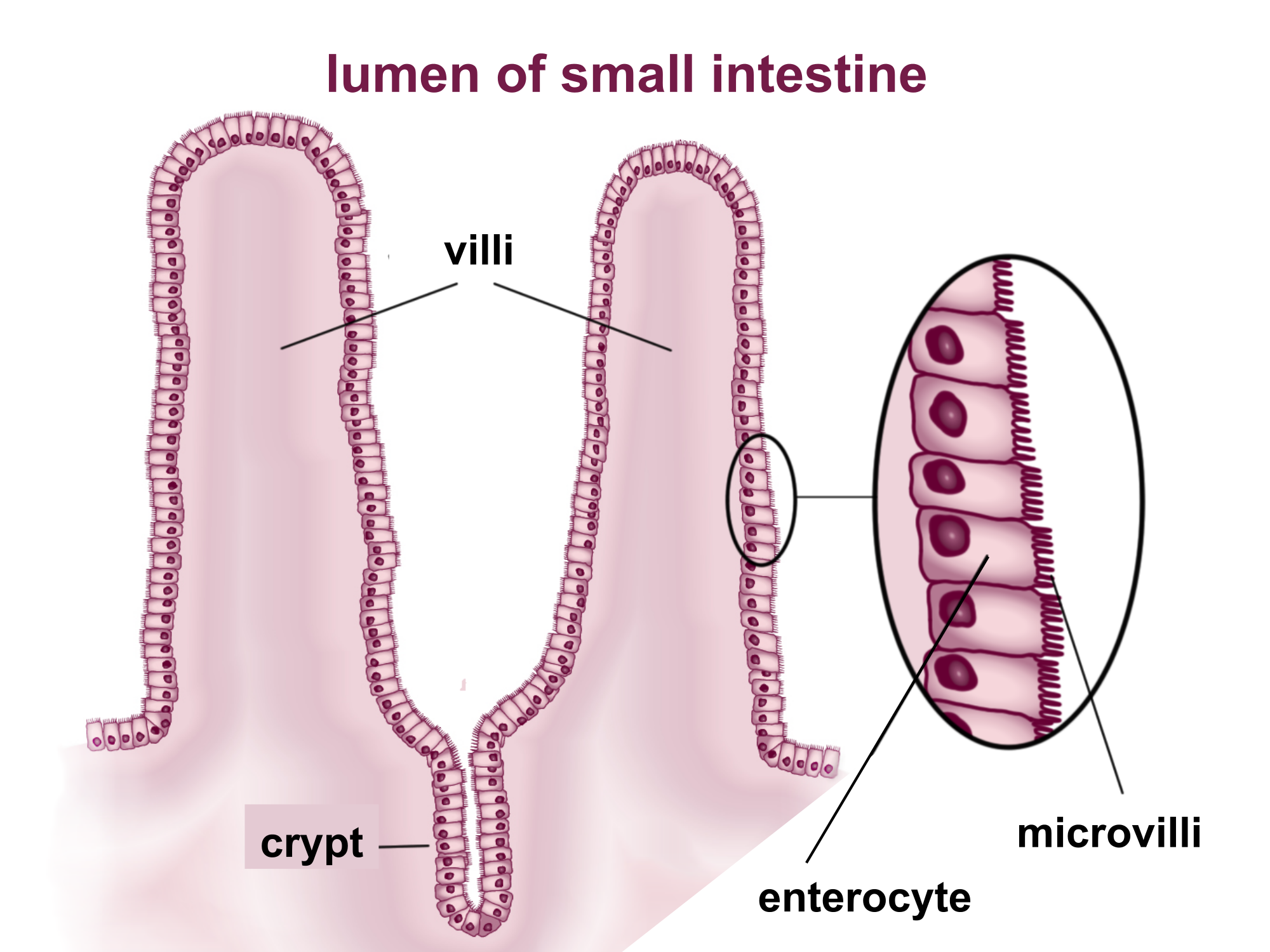
From the small intestine, any remaining nutrients and food waste pass into the large intestine. The large intestine is another tubular organ, but it is wider and shorter than the small intestine. It connects the small intestine and the anus. Waste that enters the large intestine is in a liquid state. As it passes through the large intestine, excess water is absorbed from it. The remaining solid waste — called feces — is eventually eliminated from the body through the anus.
Accessory Organs of the Digestive System
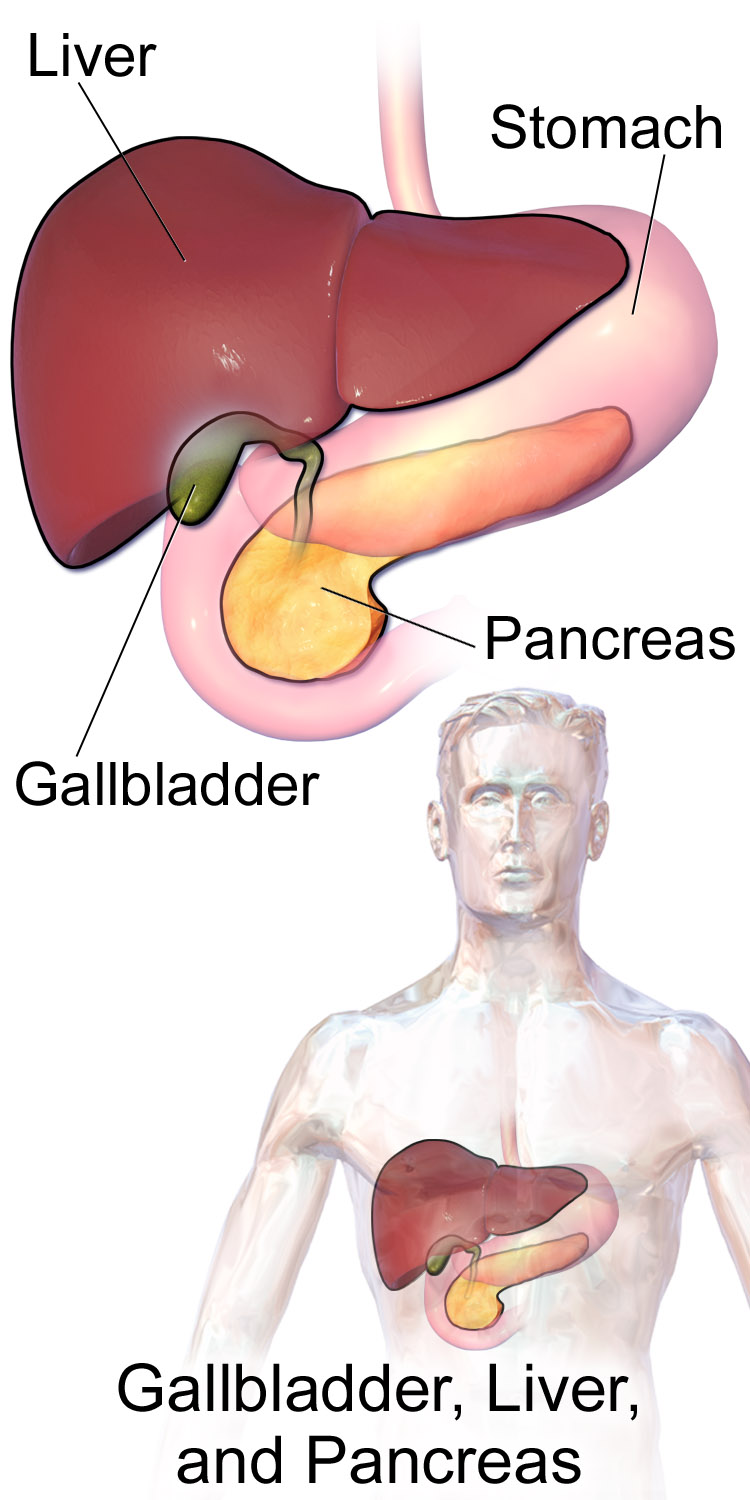
Accessory organs of the digestive system are not part of the GI tract, so they are not sites where digestion or absorption take place. Instead, these organs secrete or store substances needed for the chemical digestion of food. The accessory organs include the liver, gallbladder, and pancreas. They are shown in Figure 15.2.7 and described in the text that follows.
- The liver is an organ with multitude of functions. Its main digestive function is producing and secreting a fluid called bile, which reaches the small intestine through a duct. Bile breaks down large globules of lipids into smaller ones that are easier for enzymes to chemically digest. Bile is also needed to reduce the acidity of food entering the small intestine from the highly acidic stomach, because enzymes in the small intestine require a less acidic environment in order to work.
- The gallbladder is a small sac below the liver that stores some of the bile from the liver. The gallbladder also concentrates the bile by removing some of the water from it. It then secretes the concentrated bile into the small intestine as needed for fat digestion following a meal.
- The pancreas secretes many digestive enzymes, and releases them into the small intestine for the chemical digestion of carbohydrates, proteins, and lipids. The pancreas also helps lessen the acidity of the small intestine by secreting bicarbonate, a basic substance that neutralizes acid.
15.2 Summary
- The digestive system consists of organs that break down food, absorb its nutrients, and expel any remaining food waste.
- Digestion is the process of breaking down food into components that the body can absorb. It includes mechanical digestion and chemical digestion. Absorption is the process of taking up nutrients from food by body fluids for circulation to the rest of the body. Elimination is the process of excreting any remaining food waste after digestion and absorption are finished.
- Most digestive organs form a long, continuous tube called the gastrointestinal (GI) tract. It starts at the mouth, which is followed by the pharynx, esophagus, stomach, small intestine, and large intestine. The upper GI tract consists of the mouth through the stomach, while the lower GI tract consists of the small and large intestines.
- Digestion and/or absorption take place in most of the organs of the GI tract. Organs of the GI tract have walls that consist of several tissue layers that enable them to carry out these functions. The inner mucosa has cells that secrete digestive enzymes and other digestive substances, as well as cells that absorb nutrients. The muscle layer of the organs enables them to contract and relax in waves of peristalsis to move food through the GI tract.
- Three digestive organs — the liver, gallbladder, and pancreas — are accessory organs of digestion. They secrete substances needed for chemical digestion into the small intestine.
15.2 Review Questions
- What is the digestive system?
- What are the three main functions of the digestive system? Define each function.
-
- Relate the tissues in the walls of GI tract organs to the functions the organs perform.
15.2 Explore More
How your digestive system works – Emma Bryce, TED-Ed, 2017.
How does your body know you’re full? – Hilary Coller, TED-Ed, 2017.
Attributions
Figure 15.2.1
Ice Cream [photo] by Mark Cruz on Unsplash is used under the Unsplash License (https://unsplash.com/license).
Figure 15.2.2
Blausen_0316_DigestiveSystem by BruceBlaus on Wikimedia Commons is used under a CC BY 3.0 (https://creativecommons.org/licenses/by/3.0) license.
Figure 15.2.3
Intestinal_layers by Boumphreyfr on Wikimedia Commons is used under a CC BY-SA 3.0 (https://creativecommons.org/licenses/by-sa/3.0) license.
Figure 15.2.4
512px-Normal_gastric_mucosa_intermed_mag by Nephron on Wikimedia Commons is used under a CC BY-SA 3.0 (https://creativecommons.org/licenses/by-sa/3.0) license.
Figure 15.2.5
Peristalsis pushes food through the GI tract by CK-12 Foundation is used under a CC BY NC 3.0 (https://creativecommons.org/licenses/by-nc/3.0/) license.
Figure 15.2.6
Villi_&_microvilli_of_small_intestine.svg by BallenaBlanca on Wikimedia Commons is used under a CC BY-SA 4.0 (https://creativecommons.org/licenses/by-sa/4.0) license.
Figure 15.2.7
Blausen_0428_Gallbladder-Liver-Pancreas_Location by BruceBlaus on Wikimedia Commons is used under a CC BY 3.0 (https://creativecommons.org/licenses/by/3.0) license.
References
Blausen.com Staff. (2014). Medical gallery of Blausen Medical 2014. WikiJournal of Medicine 1 (2). DOI:10.15347/wjm/2014.010. ISSN 2002-4436.
Brainard, J/ CK-12 Foundation. (2016). Figure 4 Peristalsis pushes food through the GI tract. [digital image]. In CK-12 College Human Biology (Section 17.2) [online Flexbook]. CK12.org. https://www.ck12.org/book/ck-12-college-human-biology/section/17.2/
Mister Science. (2018). What is peristalsis? YouTube. https://www.youtube.com/channel/UCxTlkZfjArUobBAeVwzJjYg/videos
TED-Ed. (2017, November 13). How does your body know you’re full? – Hilary Coller. YouTube. https://www.youtube.com/watch?v=YVfyYrEmzgM&feature=youtu.be
TED-Ed. (2017, December 14). How your digestive system works – Emma Bryce. YouTube. https://www.youtube.com/watch?v=Og5xAdC8EUI&feature=youtu.be
A body system including a series of hollow organs joined in a long, twisting tube from the mouth to the anus. The hollow organs that make up the GI tract are the mouth, esophagus, stomach, small intestine, large intestine, and anus. The liver, pancreas, and gallbladder are the solid organs of the digestive system.

Mutant Cosplay
You probably recognize these costumed comic fans in Figure 5.8.1 as two of the four Teenage Mutant Ninja Turtles. Can a mutation really turn a reptile into an anthropomorphic superhero? Of course not — but mutations can often result in other drastic (but more realistic) changes in living things.
What Are Mutations?
Mutations are random changes in the sequence of bases in DNA or RNA. The word mutation may make you think of the Ninja Turtles, but that's a misrepresentation of how most mutations work. First of all, everyone has mutations. In fact, most people have dozens (or even hundreds!) of mutations in their DNA. Secondly, from an evolutionary perspective, mutations are essential. They are needed for evolution to occur because they are the ultimate source of all new genetic variation in any species.
Causes of Mutations
Mutations have many possible causes. Some mutations seem to happen spontaneously, without any outside influence. They occur when errors are made during DNA replication or during the transcription phase of protein synthesis. Other mutations are caused by environmental factors. Anything in the environment that can cause a mutation is known as a mutagen. Examples of mutagens are shown in the figure below.
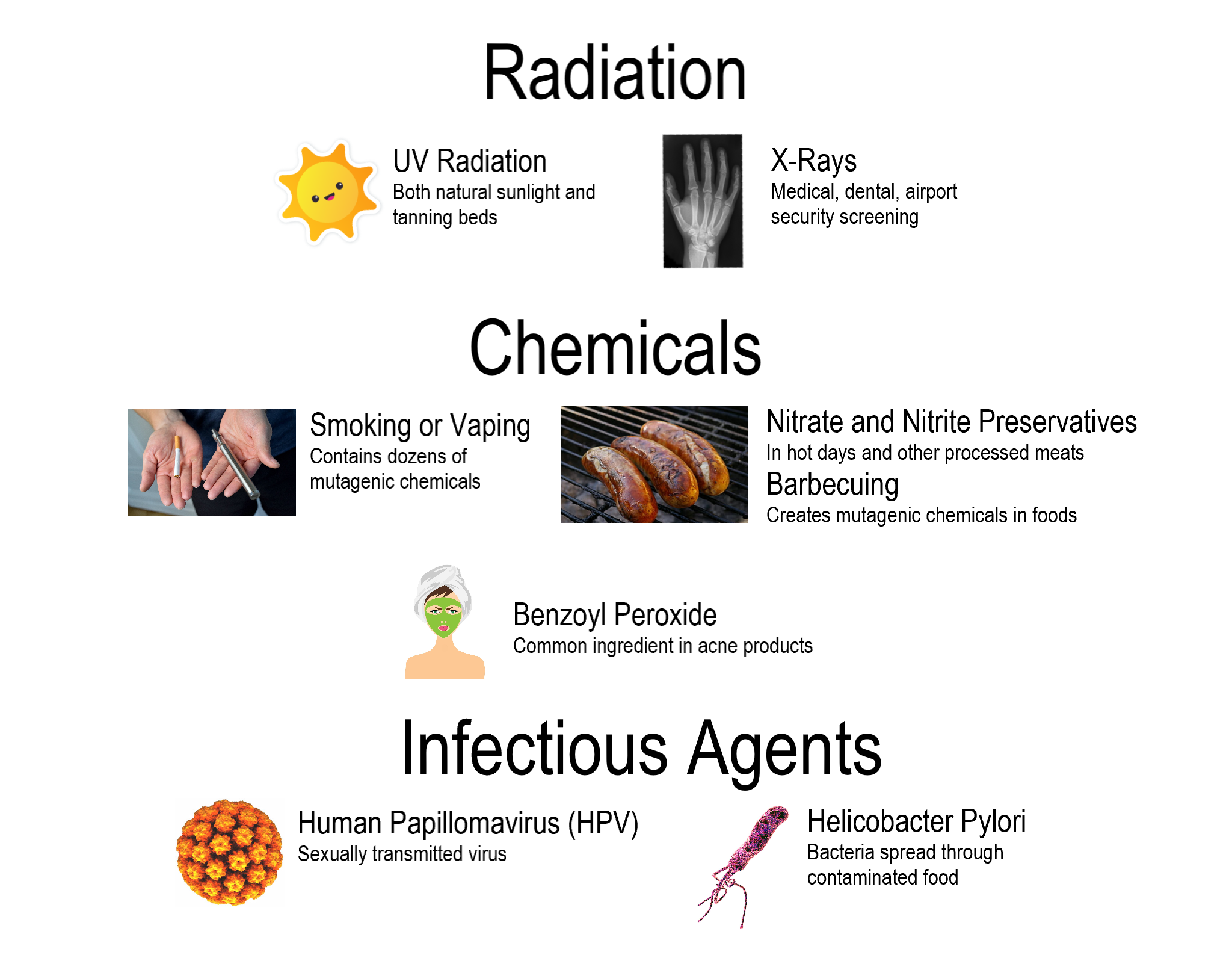
Types of Mutations
Mutations come in a variety of types. Two major categories of mutations are germline mutations and somatic mutations.
- Germline mutations occur in gametes (the sex cells), such as eggs and sperm. These mutations are especially significant because they can be transmitted to offspring, causing every cell in the offspring to carry those mutations.
- Somatic mutations occur in other cells of the body. These mutations may have little effect on the organism, because they are confined to just one cell and its daughter cells. Somatic mutations cannot be passed on to offspring.
Mutations also differ in the way that the genetic material is changed. Mutations may change an entire chromosome, or they may alter just one or a few nucleotides.
Chromosomal Alterations
Chromosomal alterations are mutations that change chromosome structure. They occur when a section of a chromosome breaks off and rejoins incorrectly, or otherwise does not rejoin at all. Possible ways in which these mutations can occur are illustrated in the figure below. Chromosomal alterations are very serious. They often result in the death of the organism in which they occur. If the organism survives, it may be affected in multiple ways. An example of a human disease caused by a chromosomal duplication is Charcot-Marie-Tooth disease type 1 (CMT1). It is characterized by muscle weakness, as well as loss of muscle tissue and sensation. The most common cause of CMT1 is a duplication of part of chromosome 17.
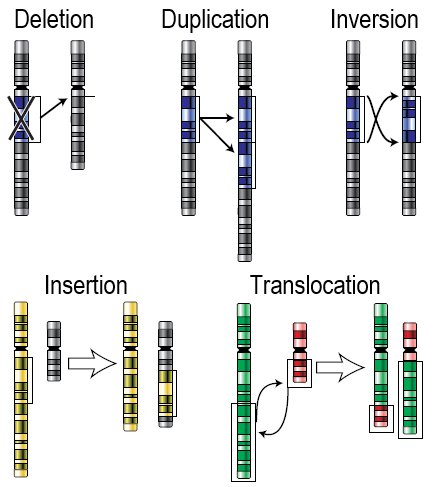
Point Mutations
A point mutation is a change in a single nucleotide in DNA. This type of mutation is usually less serious than a chromosomal alteration. An example of a point mutation is a mutation that changes the codon UUU to the codon UCU. Point mutations can be silent, missense, or nonsense mutations, as described in Table 5.8.1. The effects of point mutations depend on how they change the genetic code.
| Type | Description | Example | Effect |
|---|---|---|---|
| Silent | mutated codon codes for the same amino acid | CAA (glutamine) → CAG (glutamine) | none |
| Missense | mutated codon codes for a different amino acid | CAA (glutamine) → CCA (proline) | variable |
| Nonsense | mutated codon is a premature stop codon | CAA (glutamine) → UAA (stop) usually | serious |
Frameshift Mutations
A frameshift mutation is a deletion or insertion of one or more nucleotides, changing the reading frame of the base sequence. Deletions remove nucleotides, and insertions add nucleotides. Consider the following sequence of bases in RNA:
AUG-AAU-ACG-GCU = start-asparagine-threonine-alanine
Now, assume that an insertion occurs in this sequence. Let’s say an A nucleotide is inserted after the start codon AUG. The sequence of bases becomes:
AUG-AAA-UAC-GGC-U = start-lysine-tyrosine-glycine
Even though the rest of the sequence is unchanged, this insertion changes the reading frame and, therefore, all of the codons that follow it. As this example shows, a frameshift mutation can dramatically change how the codons in mRNA are read. This can have a drastic effect on the protein product.
Effects of Mutations
The majority of mutations have neither negative nor positive effects on the organism in which they occur. These mutations are called neutral mutations. Examples include silent point mutations, which are neutral because they do not change the amino acids in the proteins they encode.
Many other mutations have no effects on the organism because they are repaired before protein synthesis occurs. Cells have multiple repair mechanisms to fix mutations in DNA.
Beneficial Mutations
Some mutations — known as beneficial mutations — have a positive effect on the organism in which they occur. They generally code for new versions of proteins that help organisms adapt to their environment. If they increase an organism’s chances of surviving or reproducing, the mutations are likely to become more common over time. There are several well-known examples of beneficial mutations. Here are two such examples:
- Mutations have occurred in bacteria that allow the bacteria to survive in the presence of antibiotic drugs, leading to the evolution of antibiotic-resistant strains of bacteria.
- A unique mutation is found in people in Limone, a small town in Italy. The mutation protects them from developing atherosclerosis, which is the dangerous buildup of fatty materials in blood vessels despite a high-fat diet. The individual in which this mutation first appeared has even been identified and many of his descendants carry this gene.
Harmful Mutations
Imagine making a random change in a complicated machine, such as a car engine. There is a chance that the random change would result in a car that does not run well — or perhaps does not run at all. By the same token, a random change in a gene's DNA may result in the production of a protein that does not function normally... or may not function at all. Such mutations are likely to be harmful. Harmful mutations may cause genetic disorders or cancer.
- A genetic disorder is a disease, syndrome, or other abnormal condition caused by a mutation in one or more genes, or by a chromosomal alteration. An example of a genetic disorder is cystic fibrosis. A mutation in a single gene causes the body to produce thick, sticky mucus that clogs the lungs and blocks ducts in digestive organs.
- Cancer is a disease in which cells grow out of control and form abnormal masses of cells (called tumors). It is generally caused by mutations in genes that regulate the cell cycle. Because of the mutations, cells with damaged DNA are allowed to divide without restriction.
Feature: My Human Body
Inherited mutations are thought to play a role in roughly five to ten per cent of all cancers. Specific mutations that cause many of the known hereditary cancers have been identified. Most of the mutations occur in genes that control the growth of cells or the repair of damaged DNA.
Genetic testing can be done to determine whether individuals have inherited specific cancer-causing mutations. Some of the most common inherited cancers for which genetic testing is available include hereditary breast and ovarian cancer, caused by mutations in genes called BRCA1 and BRCA2. Besides breast and ovarian cancers, mutations in these genes may also cause pancreatic and prostate cancers. Genetic testing is generally done on a small sample of body fluid or tissue, such as blood, saliva, or skin cells. The sample is analyzed by a lab that specializes in genetic testing, and it usually takes at least a few weeks to get the test results.
Should you get genetic testing to find out whether you have inherited a cancer-causing mutation? Such testing is not done routinely just to screen patients for risk of cancer. Instead, the tests are generally done only when the following three criteria are met:
- The test can determine definitively whether a specific gene mutation is present. This is the case with the BRCA1 and BRCA2 gene mutations, for example.
- The test results would be useful to help guide future medical care. For example, if you found out you had a mutation in the BRCA1 or BRCA2 gene, you might get more frequent breast and ovarian cancer screenings than are generally recommended.
- You have a personal or family history that suggests you are at risk of an inherited cancer.
Criterion number 3 is based, in turn, on such factors as:
- Diagnosis of cancer at an unusually young age.
- Several different cancers occurring independently in the same individual.
- Several close genetic relatives having the same type of cancer (such as a maternal grandmother, mother, and sister all having breast cancer).
- Cancer occurring in both organs in a set of paired organs (such as both kidneys or both breasts).
If you meet the criteria for genetic testing and are advised to undergo it, genetic counseling is highly recommended. A genetic counselor can help you understand what the results mean and how to make use of them to reduce your risk of developing cancer. For example, a positive test result that shows the presence of a mutation may not necessarily mean that you will develop cancer. It may depend on whether the gene is located on an autosome or sex chromosome, and whether the mutation is dominant or recessive. Lifestyle factors may also play a role in cancer risk even for hereditary cancers. Early detection can often be life saving if cancer does develop. Genetic counseling can also help you assess the chances that any children you may have will inherit the mutation.
5.8 Summary
- Mutations are random changes in the sequence of bases in DNA or RNA. Most people have multiple mutations in their DNA without ill effects. Mutations are the ultimate source of all new genetic variation in any species.
- Mutations may happen spontaneously during DNA replication or transcription. Other mutations are caused by environmental factors called mutagens. Mutagens include radiation, certain chemicals, and some infectious agents.
- Germline mutations occur in gametes and may be passed onto offspring. Every cell in the offspring will then have the mutation. Somatic mutations occur in cells other than gametes and are confined to just one cell and its daughter cells. These mutations cannot be passed on to offspring.
- Chromosomal alterations are mutations that change chromosome structure and usually affect the organism in multiple ways. Charcot-Marie-Tooth disease type 1 is an example of a chromosomal alteration in humans.
- Point mutations are changes in a single nucleotide. The effects of point mutations depend on how they change the genetic code and may range from no effects to very serious effects.
- Frameshift mutations change the reading frame of the genetic code and are likely to have a drastic effect on the encoded protein.
- Many mutations are neutral and have no effect on the organism in which they occur. Some mutations are beneficial and improve fitness. An example is a mutation that confers antibiotic resistance in bacteria. Other mutations are harmful and decrease fitness, such as the mutations that cause genetic disorders or cancers.
5.8 Review Question
- Define mutation.
- Identify causes of mutation.
- Compare and contrast germline and somatic mutations.
- Describe chromosomal alterations, point mutations, and frameshift mutations. Identify the potential effects of each type of mutation.
- Why do many mutations have neutral effects?
- Give one example of a beneficial mutation and one example of a harmful mutation.
-
- Why do you think that exposure to mutagens (such as cigarette smoke) can cause cancer?
- Explain why the insertion or deletion of a single nucleotide can cause a frameshift mutation.
- Compare and contrast missense and nonsense mutations.
- Explain why mutations are important to evolution.
5.8 Explore More
https://www.youtube.com/watch?time_continue=51&v=PQjL4ZDuq2o&feature=emb_logo
How Radiation Changes Your DNA, Seeker, 2016.
https://www.youtube.com/watch?v=z9HIYjRRaDE&t=93s
Where do genes come from? - Carl Zimmer, TED-Ed, 2014.
https://www.youtube.com/watch?v=a63t8r70QN0&feature=youtu.be
What you should know about vaping and e-cigarettes | Suchitra Krishnan-Sarin,
TED, 2019.
Attributions
Figure 5.8.1
Ninja Turtles by Pat Loika on Flickr is used under a CC BY 2.0 (https://creativecommons.org/licenses/by/2.0/) license.
Figure 5.8.2
Separate images are all in public domain or CC licensed:
- Beauty treatment face mask by no-longer-here on Pixabay is used under the Pixabay License (https://pixabay.com/service/license/).
- HPV by AJC1 on Flickr is used under a CC BY-NC 2.0 (https://creativecommons.org/licenses/by-nc/2.0/) license.
- H Pylori by AJC1 on Flickr is used under a CC BY-NC 2.0 (https://creativecommons.org/licenses/by-nc/2.0/) license.
- Vape and Cigarette by Vaping360 on Flickr is used under a CC BY 2.0 (https://creativecommons.org/licenses/by/2.0/) license.
- Hand X-Ray by Hellerhoff on Wikimedia Commons - CC BY-SA 3.0 (https://creativecommons.org/licenses/by-sa/3.0/deed.en) license.
- Hot dogs by unknown on PxFuel is used under the Pxfuel Terms (https://www.pxfuel.com/terms-of-use).
- Sunshine face is clipart.
Figure 5.8.3
Scheme of possible chromosome mutations/ Chromosomenmutationen by unknown on Wikimedia Commons is adapted from NIH's Talking Glossary of Genetics. [Changes as described by de:user:Dietzel65]. Further use and adapation (text translated to English) by Christine Miller as image is in the public domain (https://en.wikipedia.org/wiki/Public_domain).
References
Seeker. (2016, April 23). How radiation changes your DNA. YouTube. https://www.youtube.com/watch?v=PQjL4ZDuq2o&feature=youtu.be
TED. (2019, June 5). What you should know about vaping and e-cigarettes | Suchitra Krishnan-Sarin. YouTube. https://www.youtube.com/watch?v=a63t8r70QN0&feature=youtu.be
TED-Ed. (2014, September 22). Where do genes come from? - Carl Zimmer. YouTube. https://www.youtube.com/watch?v=z9HIYjRRaDE&feature=youtu.be
Wikipedia contributors. (2020, July 6). Breast cancer. In Wikipedia. https://en.wikipedia.org/w/index.php?title=Breast_cancer&oldid=966366739
Wikipedia contributors. (2020, July 9). Charcot–Marie–Tooth disease. In Wikipedia. https://en.wikipedia.org/w/index.php?title=Charcot%E2%80%93Marie%E2%80%93Tooth_disease&oldid=966912915
Wikipedia contributors. (2020, July 7). Cystic fibrosis. In Wikipedia. https://en.wikipedia.org/w/index.php?title=Cystic_fibrosis&oldid=966566921
Wikipedia contributors. (2020, June 4). Limone sul Garda. In Wikipedia. https://en.wikipedia.org/w/index.php?title=Limone_sul_Garda&oldid=960771991
Wikipedia contributors. (2020, June 23). Ovarian cancer. In Wikipedia. https://en.wikipedia.org/w/index.php?title=Ovarian_cancer&oldid=964157192
Wikipedia contributors. (2020, May 7). BRCA mutation. In Wikipedia. https://en.wikipedia.org/w/index.php?title=BRCA_mutation&oldid=955463902
Wikipedia contributors. (2020, July 10). Teenage Mutant Ninja Turtles. In Wikipedia. https://en.wikipedia.org/w/index.php?title=Teenage_Mutant_Ninja_Turtles&oldid=967030468
Created by: CK-12/Adapted by Christine Miller

Mutant Cosplay
You probably recognize these costumed comic fans in Figure 5.8.1 as two of the four Teenage Mutant Ninja Turtles. Can a mutation really turn a reptile into an anthropomorphic superhero? Of course not — but mutations can often result in other drastic (but more realistic) changes in living things.
What Are Mutations?
Mutations are random changes in the sequence of bases in DNA or RNA. The word mutation may make you think of the Ninja Turtles, but that's a misrepresentation of how most mutations work. First of all, everyone has mutations. In fact, most people have dozens (or even hundreds!) of mutations in their DNA. Secondly, from an evolutionary perspective, mutations are essential. They are needed for evolution to occur because they are the ultimate source of all new genetic variation in any species.
Causes of Mutations
Mutations have many possible causes. Some mutations seem to happen spontaneously, without any outside influence. They occur when errors are made during DNA replication or during the transcription phase of protein synthesis. Other mutations are caused by environmental factors. Anything in the environment that can cause a mutation is known as a mutagen. Examples of mutagens are shown in the figure below.

Types of Mutations
Mutations come in a variety of types. Two major categories of mutations are germline mutations and somatic mutations.
- Germline mutations occur in gametes (the sex cells), such as eggs and sperm. These mutations are especially significant because they can be transmitted to offspring, causing every cell in the offspring to carry those mutations.
- Somatic mutations occur in other cells of the body. These mutations may have little effect on the organism, because they are confined to just one cell and its daughter cells. Somatic mutations cannot be passed on to offspring.
Mutations also differ in the way that the genetic material is changed. Mutations may change an entire chromosome, or they may alter just one or a few nucleotides.
Chromosomal Alterations
Chromosomal alterations are mutations that change chromosome structure. They occur when a section of a chromosome breaks off and rejoins incorrectly, or otherwise does not rejoin at all. Possible ways in which these mutations can occur are illustrated in the figure below. Chromosomal alterations are very serious. They often result in the death of the organism in which they occur. If the organism survives, it may be affected in multiple ways. An example of a human disease caused by a chromosomal duplication is Charcot-Marie-Tooth disease type 1 (CMT1). It is characterized by muscle weakness, as well as loss of muscle tissue and sensation. The most common cause of CMT1 is a duplication of part of chromosome 17.

Point Mutations
A point mutation is a change in a single nucleotide in DNA. This type of mutation is usually less serious than a chromosomal alteration. An example of a point mutation is a mutation that changes the codon UUU to the codon UCU. Point mutations can be silent, missense, or nonsense mutations, as described in Table 5.8.1. The effects of point mutations depend on how they change the genetic code.
| Type | Description | Example | Effect |
|---|---|---|---|
| Silent | mutated codon codes for the same amino acid | CAA (glutamine) → CAG (glutamine) | none |
| Missense | mutated codon codes for a different amino acid | CAA (glutamine) → CCA (proline) | variable |
| Nonsense | mutated codon is a premature stop codon | CAA (glutamine) → UAA (stop) usually | serious |
Frameshift Mutations
A frameshift mutation is a deletion or insertion of one or more nucleotides, changing the reading frame of the base sequence. Deletions remove nucleotides, and insertions add nucleotides. Consider the following sequence of bases in RNA:
AUG-AAU-ACG-GCU = start-asparagine-threonine-alanine
Now, assume that an insertion occurs in this sequence. Let’s say an A nucleotide is inserted after the start codon AUG. The sequence of bases becomes:
AUG-AAA-UAC-GGC-U = start-lysine-tyrosine-glycine
Even though the rest of the sequence is unchanged, this insertion changes the reading frame and, therefore, all of the codons that follow it. As this example shows, a frameshift mutation can dramatically change how the codons in mRNA are read. This can have a drastic effect on the protein product.
Effects of Mutations
The majority of mutations have neither negative nor positive effects on the organism in which they occur. These mutations are called neutral mutations. Examples include silent point mutations, which are neutral because they do not change the amino acids in the proteins they encode.
Many other mutations have no effects on the organism because they are repaired before protein synthesis occurs. Cells have multiple repair mechanisms to fix mutations in DNA.
Beneficial Mutations
Some mutations — known as beneficial mutations — have a positive effect on the organism in which they occur. They generally code for new versions of proteins that help organisms adapt to their environment. If they increase an organism’s chances of surviving or reproducing, the mutations are likely to become more common over time. There are several well-known examples of beneficial mutations. Here are two such examples:
- Mutations have occurred in bacteria that allow the bacteria to survive in the presence of antibiotic drugs, leading to the evolution of antibiotic-resistant strains of bacteria.
- A unique mutation is found in people in Limone, a small town in Italy. The mutation protects them from developing atherosclerosis, which is the dangerous buildup of fatty materials in blood vessels despite a high-fat diet. The individual in which this mutation first appeared has even been identified and many of his descendants carry this gene.
Harmful Mutations
Imagine making a random change in a complicated machine, such as a car engine. There is a chance that the random change would result in a car that does not run well — or perhaps does not run at all. By the same token, a random change in a gene's DNA may result in the production of a protein that does not function normally... or may not function at all. Such mutations are likely to be harmful. Harmful mutations may cause genetic disorders or cancer.
- A genetic disorder is a disease, syndrome, or other abnormal condition caused by a mutation in one or more genes, or by a chromosomal alteration. An example of a genetic disorder is cystic fibrosis. A mutation in a single gene causes the body to produce thick, sticky mucus that clogs the lungs and blocks ducts in digestive organs.
- Cancer is a disease in which cells grow out of control and form abnormal masses of cells (called tumors). It is generally caused by mutations in genes that regulate the cell cycle. Because of the mutations, cells with damaged DNA are allowed to divide without restriction.
Feature: My Human Body
Inherited mutations are thought to play a role in roughly five to ten per cent of all cancers. Specific mutations that cause many of the known hereditary cancers have been identified. Most of the mutations occur in genes that control the growth of cells or the repair of damaged DNA.
Genetic testing can be done to determine whether individuals have inherited specific cancer-causing mutations. Some of the most common inherited cancers for which genetic testing is available include hereditary breast and ovarian cancer, caused by mutations in genes called BRCA1 and BRCA2. Besides breast and ovarian cancers, mutations in these genes may also cause pancreatic and prostate cancers. Genetic testing is generally done on a small sample of body fluid or tissue, such as blood, saliva, or skin cells. The sample is analyzed by a lab that specializes in genetic testing, and it usually takes at least a few weeks to get the test results.
Should you get genetic testing to find out whether you have inherited a cancer-causing mutation? Such testing is not done routinely just to screen patients for risk of cancer. Instead, the tests are generally done only when the following three criteria are met:
- The test can determine definitively whether a specific gene mutation is present. This is the case with the BRCA1 and BRCA2 gene mutations, for example.
- The test results would be useful to help guide future medical care. For example, if you found out you had a mutation in the BRCA1 or BRCA2 gene, you might get more frequent breast and ovarian cancer screenings than are generally recommended.
- You have a personal or family history that suggests you are at risk of an inherited cancer.
Criterion number 3 is based, in turn, on such factors as:
- Diagnosis of cancer at an unusually young age.
- Several different cancers occurring independently in the same individual.
- Several close genetic relatives having the same type of cancer (such as a maternal grandmother, mother, and sister all having breast cancer).
- Cancer occurring in both organs in a set of paired organs (such as both kidneys or both breasts).
If you meet the criteria for genetic testing and are advised to undergo it, genetic counseling is highly recommended. A genetic counselor can help you understand what the results mean and how to make use of them to reduce your risk of developing cancer. For example, a positive test result that shows the presence of a mutation may not necessarily mean that you will develop cancer. It may depend on whether the gene is located on an autosome or sex chromosome, and whether the mutation is dominant or recessive. Lifestyle factors may also play a role in cancer risk even for hereditary cancers. Early detection can often be life saving if cancer does develop. Genetic counseling can also help you assess the chances that any children you may have will inherit the mutation.
5.8 Summary
- Mutations are random changes in the sequence of bases in DNA or RNA. Most people have multiple mutations in their DNA without ill effects. Mutations are the ultimate source of all new genetic variation in any species.
- Mutations may happen spontaneously during DNA replication or transcription. Other mutations are caused by environmental factors called mutagens. Mutagens include radiation, certain chemicals, and some infectious agents.
- Germline mutations occur in gametes and may be passed onto offspring. Every cell in the offspring will then have the mutation. Somatic mutations occur in cells other than gametes and are confined to just one cell and its daughter cells. These mutations cannot be passed on to offspring.
- Chromosomal alterations are mutations that change chromosome structure and usually affect the organism in multiple ways. Charcot-Marie-Tooth disease type 1 is an example of a chromosomal alteration in humans.
- Point mutations are changes in a single nucleotide. The effects of point mutations depend on how they change the genetic code and may range from no effects to very serious effects.
- Frameshift mutations change the reading frame of the genetic code and are likely to have a drastic effect on the encoded protein.
- Many mutations are neutral and have no effect on the organism in which they occur. Some mutations are beneficial and improve fitness. An example is a mutation that confers antibiotic resistance in bacteria. Other mutations are harmful and decrease fitness, such as the mutations that cause genetic disorders or cancers.
5.8 Review Question
- Define mutation.
- Identify causes of mutation.
- Compare and contrast germline and somatic mutations.
- Describe chromosomal alterations, point mutations, and frameshift mutations. Identify the potential effects of each type of mutation.
- Why do many mutations have neutral effects?
- Give one example of a beneficial mutation and one example of a harmful mutation.
-
- Why do you think that exposure to mutagens (such as cigarette smoke) can cause cancer?
- Explain why the insertion or deletion of a single nucleotide can cause a frameshift mutation.
- Compare and contrast missense and nonsense mutations.
- Explain why mutations are important to evolution.
5.8 Explore More
https://www.youtube.com/watch?time_continue=51&v=PQjL4ZDuq2o&feature=emb_logo
How Radiation Changes Your DNA, Seeker, 2016.
https://www.youtube.com/watch?v=z9HIYjRRaDE&t=93s
Where do genes come from? - Carl Zimmer, TED-Ed, 2014.
https://www.youtube.com/watch?v=a63t8r70QN0&feature=youtu.be
What you should know about vaping and e-cigarettes | Suchitra Krishnan-Sarin,
TED, 2019.
Attributions
Figure 5.8.1
Ninja Turtles by Pat Loika on Flickr is used under a CC BY 2.0 (https://creativecommons.org/licenses/by/2.0/) license.
Figure 5.8.2
Separate images are all in public domain or CC licensed:
- Beauty treatment face mask by no-longer-here on Pixabay is used under the Pixabay License (https://pixabay.com/service/license/).
- HPV by AJC1 on Flickr is used under a CC BY-NC 2.0 (https://creativecommons.org/licenses/by-nc/2.0/) license.
- H Pylori by AJC1 on Flickr is used under a CC BY-NC 2.0 (https://creativecommons.org/licenses/by-nc/2.0/) license.
- Vape and Cigarette by Vaping360 on Flickr is used under a CC BY 2.0 (https://creativecommons.org/licenses/by/2.0/) license.
- Hand X-Ray by Hellerhoff on Wikimedia Commons - CC BY-SA 3.0 (https://creativecommons.org/licenses/by-sa/3.0/deed.en) license.
- Hot dogs by unknown on PxFuel is used under the Pxfuel Terms (https://www.pxfuel.com/terms-of-use).
- Sunshine face is clipart.
Figure 5.8.3
Scheme of possible chromosome mutations/ Chromosomenmutationen by unknown on Wikimedia Commons is adapted from NIH's Talking Glossary of Genetics. [Changes as described by de:user:Dietzel65]. Further use and adapation (text translated to English) by Christine Miller as image is in the public domain (https://en.wikipedia.org/wiki/Public_domain).
References
Seeker. (2016, April 23). How radiation changes your DNA. YouTube. https://www.youtube.com/watch?v=PQjL4ZDuq2o&feature=youtu.be
TED. (2019, June 5). What you should know about vaping and e-cigarettes | Suchitra Krishnan-Sarin. YouTube. https://www.youtube.com/watch?v=a63t8r70QN0&feature=youtu.be
TED-Ed. (2014, September 22). Where do genes come from? - Carl Zimmer. YouTube. https://www.youtube.com/watch?v=z9HIYjRRaDE&feature=youtu.be
Wikipedia contributors. (2020, July 6). Breast cancer. In Wikipedia. https://en.wikipedia.org/w/index.php?title=Breast_cancer&oldid=966366739
Wikipedia contributors. (2020, July 9). Charcot–Marie–Tooth disease. In Wikipedia. https://en.wikipedia.org/w/index.php?title=Charcot%E2%80%93Marie%E2%80%93Tooth_disease&oldid=966912915
Wikipedia contributors. (2020, July 7). Cystic fibrosis. In Wikipedia. https://en.wikipedia.org/w/index.php?title=Cystic_fibrosis&oldid=966566921
Wikipedia contributors. (2020, June 4). Limone sul Garda. In Wikipedia. https://en.wikipedia.org/w/index.php?title=Limone_sul_Garda&oldid=960771991
Wikipedia contributors. (2020, June 23). Ovarian cancer. In Wikipedia. https://en.wikipedia.org/w/index.php?title=Ovarian_cancer&oldid=964157192
Wikipedia contributors. (2020, May 7). BRCA mutation. In Wikipedia. https://en.wikipedia.org/w/index.php?title=BRCA_mutation&oldid=955463902
Wikipedia contributors. (2020, July 10). Teenage Mutant Ninja Turtles. In Wikipedia. https://en.wikipedia.org/w/index.php?title=Teenage_Mutant_Ninja_Turtles&oldid=967030468
A stem cell can become any type of body cell based on gene regulation. Types of cells a stem cell can become include, but are not limited to: Sex cells, muscle cells, fat cells, immune cells, bone cells, epithelial cells, nervous cells, and blood cells.
Structures containing neuronal cell bodies in the peripheral nervous system.
Image shows components of DNA regulating transcription. One a section of DNA regulating a specific gene, upstream, there is an enhancer, promoter sequences, and the TATA box. These preceded the coding strand section of DNA which includes introns and exons.
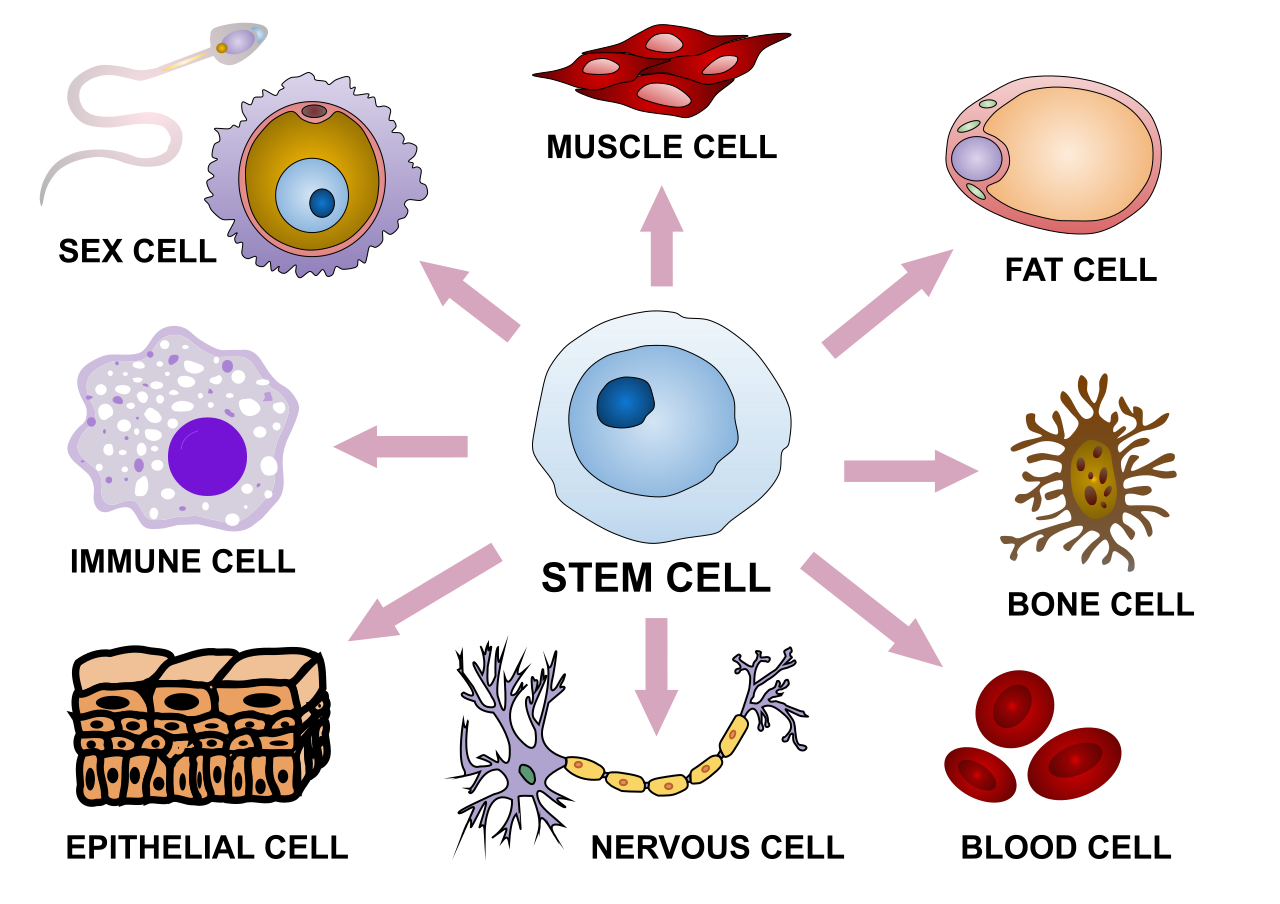
Express Yourself
This sketch illustrates some of the variability in human cells. The shape and other characteristics that make each type of cell unique depend mainly on the specific proteins that particular cell type makes. Proteins are encoded in genes. All the cells in an organism have the same genes, so they all have genetic instructions for the same proteins. Obviously, different types of cells must use (or express) different genes to make different proteins.
What Is Gene Expression?
Using a gene to make a protein is called gene expression. It includes the synthesis of the protein by the processes of transcription of DNA into mRNA, and translation of mRNA into a protein. It may also include further processing of the protein after synthesis.
Gene expression is regulated to ensure that the correct proteins are made when and where they are needed. Regulation may occur at any point in the expression of a gene, from the start of the transcription phase of protein synthesis to the processing of a protein after synthesis occurs. The regulation of transcription is one of the most complicated parts of gene regulation in eukaryotic cells, and it is the focus of this concept.
Regulation of Transcription
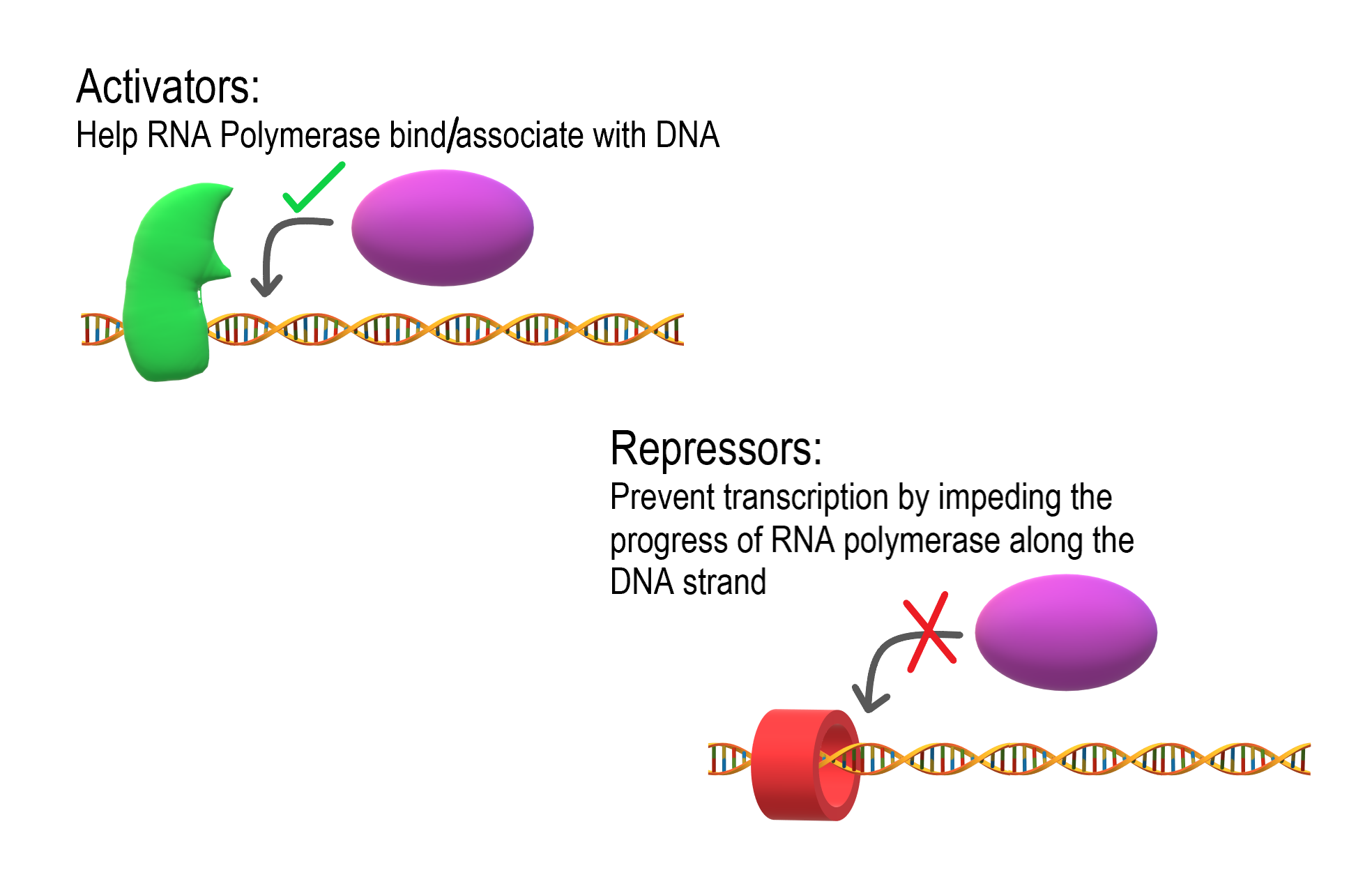
As shown in Figure 5.9.2, transcription is controlled by regulatory proteins. These proteins bind to regions of DNA, called regulatory elements, which are located near promoters. The promoter is the region of a gene where RNA polymerase binds to initiate transcription of the DNA to mRNA. After regulatory proteins bind to regulatory elements, the proteins can interact with RNA polymerase. Regulatory proteins are typically either activators or repressors. Activators are regulatory proteins that promote transcription by enhancing the interaction of RNA polymerase with the promoter. Repressors are regulatory proteins that prevent transcription by impeding the progress of RNA polymerase along the DNA strand, so the DNA cannot be transcribed to mRNA.
Enhancers
Although regulatory proteins and elements are typically the key players in the regulation of transcription, other factors may also be involved. Regulation of transcription may also involve enhancers. Enhancers are distant regions of DNA that can loop back to interact with a gene's promoter. They can also increase the likelihood that transcription of the gene will occur.Enhancers
The TATA Box
Different types of cells have unique patterns of regulatory elements that result in only the necessary genes being transcribed. That’s why a blood cell and nerve cell, for example, are so different from each other. Some regulatory elements, however, are common to virtually all genes, regardless of the cells in which they occur. An example is the TATA box, which is a regulatory element that is part of the promoter of almost every eukaryotic gene. A number of regulatory proteins bind to the TATA box, forming a multi-protein complex. It is only when all of the appropriate proteins are bound to the TATA box that RNA polymerase recognizes the complex and binds to the promoter so transcription can begin.

Regulation During Development
The regulation of gene expression is extremely important in an organism's early development. Regulatory proteins must "turn on" certain genes in particular cells at just the right time, so the individual develops normal organs and organ systems. Homeobox genes are important genes that regulate development.
Homeobox genes are a large group of similar genes that direct the formation of many body structures during the embryonic stage. In humans, there are an estimated 235 functional homeobox genes. They are present on every chromosome and generally grouped in clusters. Homeobox genes contain instructions for making chains of 60 amino acids, called homeodomains. Proteins containing homeodomains are transcription factors that bind to and control the activities of other genes. The homeodomain is the part of the protein that binds to the target gene and controls its expression.
Gene Expression and Cancer
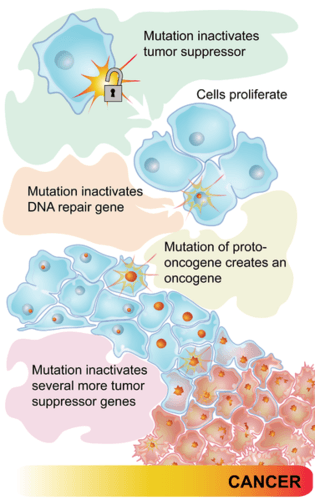
Some types of cancer occur because of mutations in the genes that control the cell cycle. Cancer-causing mutations most often occur in two types of regulatory genes: proto-oncogenes and tumor-suppressor genes. Both are shown in Figure 5.9.4.
- Proto-oncogenes are genes that normally help cells divide. When a proto-oncogene mutates to become an oncogene, it is continuously expressed, even when it is not supposed to be. This is like a car's accelerator pedal being stuck at full throttle. The car keeps racing at top speed. A cell, in this case, keeps dividing out of control, which can lead to cancer.
- Tumor suppressor genes are genes that normally slow down or stop cell division. When a mutation occurs in a tumor suppressor gene, it can no longer control cell division. This is like a car without brakes. The car can't be slowed or stopped. A cell, in this case, keeps dividing out of control, which can lead to cancer.
5.9 Summary
- Using a gene to make a protein is called gene expression. Gene expression is regulated to ensure that the correct proteins are made when and where they are needed. Regulation may occur at any stage of protein synthesis or processing.
- The regulation of transcription is controlled by regulatory proteins that bind to regions of DNA called regulatory elements, which are usually located near promoters. Most regulatory proteins are either activators that promote transcription, or repressors that impede transcription.
- A regulatory element common to almost all eukaryotic genes is the TATA box. A number of regulatory proteins must bind to the TATA box in the promoter before transcription can proceed.
- Regulation of gene expression is extremely important during an organism's early development. Homeobox genes — which encode for chains of amino acids called homeodomains — are important genes that regulate development.
- Some types of cancer occur because of mutations in the genes that control the cell cycle. Cancer-causing mutations most often occur in two types of regulatory genes: tumor-suppressor genes and proto-oncogenes.
5.9 Review Questions
- Define gene expression.
- Why must gene expression be regulated?
- Explain how regulatory proteins may activate or repress transcription.
-
- What is the TATA box, and how does it work?
- Describe homeobox genes and their role in an organism's development.
- Discuss the role of regulatory gene mutations in cancer.
- Explain the relationship between proto-oncogenes and oncogenes.
- If a newly fertilized egg contained a mutation in a homeobox gene, how do you think this would affect the developing embryo? Explain your answer.
- Compare and contrast enhancers and activators.
5.9 Explore More
https://www.youtube.com/watch?time_continue=3&v=vi-zWoobt_Q&feature=emb_logo
Regulated Transcription, ndsuvirtualcell, 2008.
https://www.youtube.com/watch?v=BmFEoCFDi-w
How do cancer cells behave differently from healthy ones? - George Zaidan,
TED-Ed, 2012.
https://www.youtube.com/watch?v=Z3B-AaqjyjE
What is leukemia? - Danilo Allegra and Dania Puggioni, 2015.
Attributions
Figure 5.9.1
Stem_cell_differentiation.svg by Haileyfournier on Wikimedia Commons is used under a CC BY-SA 4.0 (https://creativecommons.org/licenses/by-sa/4.0) license.
Figure 5.9.2
Activators and Repressors by Christine Miller is used under a CC BY-SA 4.0 (https://creativecommons.org/licenses/by-sa/4.0) license.
Figure 5.9.3
TATA_box_description by Luttysar on Wikimedia Commons is used under a CC BY-SA 4.0 (https://creativecommons.org/licenses/by-sa/4.0) license.
Figure 5.9.4
Pathways to cancer by CK-12 Foundation is used under a CC BY-NC 3.0 (http://creativecommons.org/licenses/by-nc/3.0/) license.
 ©CK-12 Foundation Licensed under
©CK-12 Foundation Licensed under ![]() • Terms of Use • Attribution
• Terms of Use • Attribution
References
Brainard, J/ CK-12 Foundation. (2012). Figure 3 Flow chart (series of mutations leading to cancer) [digital image]. In CK-12 College Human Biology (Section 5.8) [online Flexbook]. CK12.org. https://www.ck12.org/c/physical-science/concentration/?referrer=crossref
ndsuvirtualcell.(2008). Regulated transcription. YouTube. https://www.youtube.com/watch?v=vi-zWoobt_Q&feature=youtu.be
TED-Ed. (2012, December 5). How do cancer cells behave differently from healthy ones? - George Zaidan. YouTube. https://www.youtube.com/watch?v=BmFEoCFDi-w&feature=youtu.be
TED-Ed. (2015, April 15). What is leukemia? - Danilo Allegra and Dania Puggioni. YouTube. https://www.youtube.com/watch?v=Z3B-AaqjyjE&feature=youtu.be
A chameleon on a branch, surrounded by foliage. The chameleon is camouflaged to blend into its surroundings.
Created by: CK-12/Adapted by Christine Miller

Express Yourself
This sketch illustrates some of the variability in human cells. The shape and other characteristics that make each type of cell unique depend mainly on the specific proteins that particular cell type makes. Proteins are encoded in genes. All the cells in an organism have the same genes, so they all have genetic instructions for the same proteins. Obviously, different types of cells must use (or express) different genes to make different proteins.
What Is Gene Expression?
Using a gene to make a protein is called gene expression. It includes the synthesis of the protein by the processes of transcription of DNA into mRNA, and translation of mRNA into a protein. It may also include further processing of the protein after synthesis.
Gene expression is regulated to ensure that the correct proteins are made when and where they are needed. Regulation may occur at any point in the expression of a gene, from the start of the transcription phase of protein synthesis to the processing of a protein after synthesis occurs. The regulation of transcription is one of the most complicated parts of gene regulation in eukaryotic cells, and it is the focus of this concept.
Regulation of Transcription

As shown in Figure 5.9.2, transcription is controlled by regulatory proteins. These proteins bind to regions of DNA, called regulatory elements, which are located near promoters. The promoter is the region of a gene where RNA polymerase binds to initiate transcription of the DNA to mRNA. After regulatory proteins bind to regulatory elements, the proteins can interact with RNA polymerase. Regulatory proteins are typically either activators or repressors. Activators are regulatory proteins that promote transcription by enhancing the interaction of RNA polymerase with the promoter. Repressors are regulatory proteins that prevent transcription by impeding the progress of RNA polymerase along the DNA strand, so the DNA cannot be transcribed to mRNA.
Enhancers
Although regulatory proteins and elements are typically the key players in the regulation of transcription, other factors may also be involved. Regulation of transcription may also involve enhancers. Enhancers are distant regions of DNA that can loop back to interact with a gene's promoter. They can also increase the likelihood that transcription of the gene will occur.Enhancers
The TATA Box
Different types of cells have unique patterns of regulatory elements that result in only the necessary genes being transcribed. That’s why a blood cell and nerve cell, for example, are so different from each other. Some regulatory elements, however, are common to virtually all genes, regardless of the cells in which they occur. An example is the TATA box, which is a regulatory element that is part of the promoter of almost every eukaryotic gene. A number of regulatory proteins bind to the TATA box, forming a multi-protein complex. It is only when all of the appropriate proteins are bound to the TATA box that RNA polymerase recognizes the complex and binds to the promoter so transcription can begin.

Regulation During Development
The regulation of gene expression is extremely important in an organism's early development. Regulatory proteins must "turn on" certain genes in particular cells at just the right time, so the individual develops normal organs and organ systems. Homeobox genes are important genes that regulate development.
Homeobox genes are a large group of similar genes that direct the formation of many body structures during the embryonic stage. In humans, there are an estimated 235 functional homeobox genes. They are present on every chromosome and generally grouped in clusters. Homeobox genes contain instructions for making chains of 60 amino acids, called homeodomains. Proteins containing homeodomains are transcription factors that bind to and control the activities of other genes. The homeodomain is the part of the protein that binds to the target gene and controls its expression.
Gene Expression and Cancer

Some types of cancer occur because of mutations in the genes that control the cell cycle. Cancer-causing mutations most often occur in two types of regulatory genes: proto-oncogenes and tumor-suppressor genes. Both are shown in Figure 5.9.4.
- Proto-oncogenes are genes that normally help cells divide. When a proto-oncogene mutates to become an oncogene, it is continuously expressed, even when it is not supposed to be. This is like a car's accelerator pedal being stuck at full throttle. The car keeps racing at top speed. A cell, in this case, keeps dividing out of control, which can lead to cancer.
- Tumor suppressor genes are genes that normally slow down or stop cell division. When a mutation occurs in a tumor suppressor gene, it can no longer control cell division. This is like a car without brakes. The car can't be slowed or stopped. A cell, in this case, keeps dividing out of control, which can lead to cancer.
5.9 Summary
- Using a gene to make a protein is called gene expression. Gene expression is regulated to ensure that the correct proteins are made when and where they are needed. Regulation may occur at any stage of protein synthesis or processing.
- The regulation of transcription is controlled by regulatory proteins that bind to regions of DNA called regulatory elements, which are usually located near promoters. Most regulatory proteins are either activators that promote transcription, or repressors that impede transcription.
- A regulatory element common to almost all eukaryotic genes is the TATA box. A number of regulatory proteins must bind to the TATA box in the promoter before transcription can proceed.
- Regulation of gene expression is extremely important during an organism's early development. Homeobox genes — which encode for chains of amino acids called homeodomains — are important genes that regulate development.
- Some types of cancer occur because of mutations in the genes that control the cell cycle. Cancer-causing mutations most often occur in two types of regulatory genes: tumor-suppressor genes and proto-oncogenes.
5.9 Review Questions
- Define gene expression.
- Why must gene expression be regulated?
- Explain how regulatory proteins may activate or repress transcription.
-
- What is the TATA box, and how does it work?
- Describe homeobox genes and their role in an organism's development.
- Discuss the role of regulatory gene mutations in cancer.
- Explain the relationship between proto-oncogenes and oncogenes.
- If a newly fertilized egg contained a mutation in a homeobox gene, how do you think this would affect the developing embryo? Explain your answer.
- Compare and contrast enhancers and activators.
5.9 Explore More
https://www.youtube.com/watch?time_continue=3&v=vi-zWoobt_Q&feature=emb_logo
Regulated Transcription, ndsuvirtualcell, 2008.
https://www.youtube.com/watch?v=BmFEoCFDi-w
How do cancer cells behave differently from healthy ones? - George Zaidan,
TED-Ed, 2012.
https://www.youtube.com/watch?v=Z3B-AaqjyjE
What is leukemia? - Danilo Allegra and Dania Puggioni, 2015.
Attributions
Figure 5.9.1
Stem_cell_differentiation.svg by Haileyfournier on Wikimedia Commons is used under a CC BY-SA 4.0 (https://creativecommons.org/licenses/by-sa/4.0) license.
Figure 5.9.2
Activators and Repressors by Christine Miller is used under a CC BY-SA 4.0 (https://creativecommons.org/licenses/by-sa/4.0) license.
Figure 5.9.3
TATA_box_description by Luttysar on Wikimedia Commons is used under a CC BY-SA 4.0 (https://creativecommons.org/licenses/by-sa/4.0) license.
Figure 5.9.4
Pathways to cancer by CK-12 Foundation is used under a CC BY-NC 3.0 (http://creativecommons.org/licenses/by-nc/3.0/) license.
 ©CK-12 Foundation Licensed under
©CK-12 Foundation Licensed under ![]() • Terms of Use • Attribution
• Terms of Use • Attribution
References
Brainard, J/ CK-12 Foundation. (2012). Figure 3 Flow chart (series of mutations leading to cancer) [digital image]. In CK-12 College Human Biology (Section 5.8) [online Flexbook]. CK12.org. https://www.ck12.org/c/physical-science/concentration/?referrer=crossref
ndsuvirtualcell.(2008). Regulated transcription. YouTube. https://www.youtube.com/watch?v=vi-zWoobt_Q&feature=youtu.be
TED-Ed. (2012, December 5). How do cancer cells behave differently from healthy ones? - George Zaidan. YouTube. https://www.youtube.com/watch?v=BmFEoCFDi-w&feature=youtu.be
TED-Ed. (2015, April 15). What is leukemia? - Danilo Allegra and Dania Puggioni. YouTube. https://www.youtube.com/watch?v=Z3B-AaqjyjE&feature=youtu.be
Figure 5.10.1
Image shows a photograph of Gregor Mendel.
Image shows a Lego (TM) representation of Gregor Mendel with his plants.
Image shows a table with illustrations showing the variation that exists within pea plans. The peas can either be smooth or wrinkled. The peas can either be green or yellow. The flowers could either be white or purple. The pods could either be smooth or constricted. The pods could either be yellow or green. The plants could either be short or tall. The plants could either end with flowers or end with foliage.
Image shows the inheritance pattern of blossom colour in pea plants. In the parental generation, a purple blossomed plant was crossed with a white blossomed plant. In the next generation (F1), all blossoms were purple. When the F1 generation self-pollinated, 75% of the resulting F2 generation had purple blossoms while the remaining 25% had white blossoms.
Teosinte (top) is the ancestor of modern corn. Hybrids (middle) were created using artificial selection, until modern corn (bottom) was developed.
The teosinte is very small. It has only about 10 kernels, each of which are encased in a hard shell. The hybrid corns is slightly larger, and the individual seed casing is reduced. The modern corn has many, many kernels, each with no individual casing.
Of Peas and People

These purple-flowered plants are not just pretty to look at. Plants like these led to a huge leap forward in biology. They're common garden peas, and they were studied in the mid-1800s by an Austrian monk named Gregor Mendel. Through careful experimentation, Mendel uncovered the secrets of heredity, or how parents pass characteristics to their offspring. You may not care much about heredity in pea plants, but you probably care about your own heredity. Mendel's discoveries apply to people, as well as to peas — and to all other living things that reproduce sexually. In this concept, you will read about Mendel's experiments and the secrets of heredity that he discovered.
Mendel and His Pea Plants

Gregor Mendel (Figure 5.10.2) was born in 1822. He grew up on his parents’ farm in Austria. He did well in school and became a friar (and later an abbot) at St. Thomas' Abbey. Through sponsorship from the monastery, he went on to the University of Vienna, where he studied science and math. His professors encouraged him to learn science through experimentation, and to use math to make sense of his results. Mendel is best known for his experiments with pea plants (like the purple flower pictured in Figure 5.10.1).
Blending Theory of Inheritance
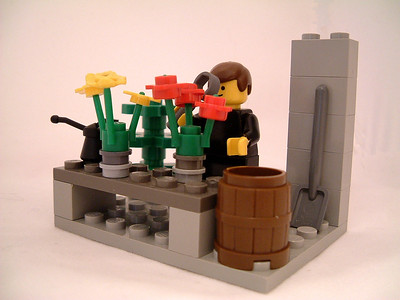
During Mendel's time, the blending theory of inheritance was popular. According to this theory, offspring have a blend (or mix) of their parents' characteristics. Mendel, however, noticed plants in his own garden that weren’t a blend of the parents. For example, a tall plant and a short plant had offspring that were either tall or short — not medium in height. Observations such as these led Mendel to question the blending theory. He wondered if there was a different underlying principle that could explain how characteristics are inherited. He decided to experiment with pea plants to find out. In fact, Mendel experimented with almost 30 thousand pea plants over the next several years!
Why Study Pea Plants?
Why did Mendel choose common, garden-variety pea plants for his experiments? Pea plants are a good choice because they are fast-growing and easy to raise. They also have several visible characteristics that can vary. These characteristics — some of which are illustrated in Figure 5.10.4 — include seed form and colour, flower colour, pod form and colour, placement of pods and flowers on stems, and stem length. Each of these characteristics has two common values. For example, seed form may be round or wrinkled, and flower colour may be white or purple (violet).
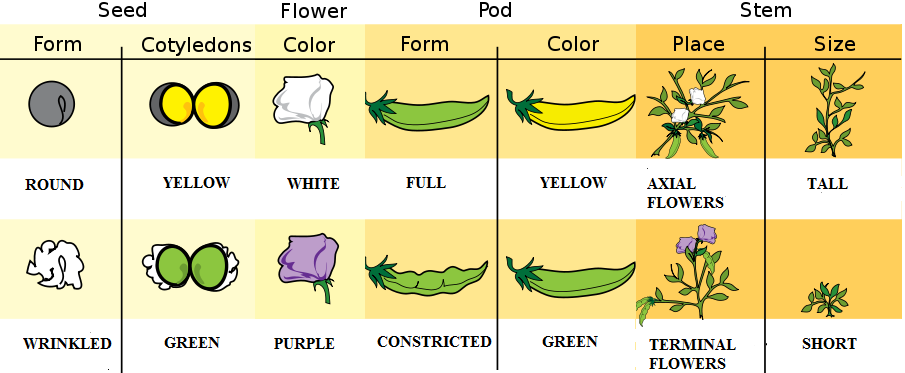
Controlling Pollination
To research how characteristics are passed from parents to offspring, Mendel needed to control pollination, which is the fertilization step in the sexual reproduction of plants. Pollen consists of tiny grains that are the male sex cells (or gametes) of plants. They are produced by a male flower part called the anther. Pollination occurs when pollen is transferred from the anther to the stigma of the same or another flower. The stigma is a female part of a flower, and it passes pollen grains to female gametes in the ovary.
Pea plants are naturally self-pollinating. In self-pollination, pollen grains from anthers on one plant are transferred to stigmas of flowers on the same plant. Mendel was interested in the offspring of two different parent plants, so he had to prevent self-pollination. He removed the anthers from the flowers of some of the plants in his experiments. Then he pollinated them by hand using a small paintbrush with pollen from other parent plants of his choice.
When pollen from one plant fertilizes another plant of the same species, it is called cross-pollination. The offspring that result from such a cross are called hybrids. When the term hybrid is used in this context, it refers to any offspring resulting from the breeding of two genetically distinct individuals.
Mendel's First Set of Experiments
At first, Mendel experimented with just one characteristic at a time. He began with flower colour. As shown in Figure 5.10.5, Mendel cross-pollinated purple- and white-flowered parent plants. The parent plants in the experiments are referred to as the P (for parent) generation.
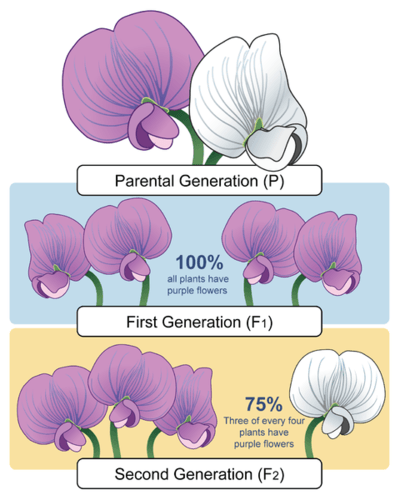
Figure 5.10.5 shows Mendel's first experiment with pea plants. The F1 generation results from the cross-pollination of two parent (P) plants, and it contains all purple flowers. The F2 generation results from the self-pollination of F1 plants, and contains 75% purple flowers and 25% white flowers.
F1 and F2 Generations
The offspring of the P generation are called the F1 (for filial, or “offspring”) generation. As shown in Figure 5.10.5, all of the plants in the F1 generation had purple flowers — none of them had white flowers. Mendel wondered what had happened to the white-flower characteristic. He assumed that some type of inherited factor produces white flowers and some other inherited factor produces purple flowers. Did the white-flower factor just disappear in the F1 generation? If so, then the offspring of the F1 generation — called the F2 generation — should all have purple flowers like their parents.
To test this prediction, Mendel allowed the F1 generation plants to self-pollinate. He was surprised by the results. Some of the F2 generation plants had white flowers. He studied hundreds of F2 generation plants, and for every three purple-flowered plants, there was an average of one white-flowered plant.
Law of Segregation
Mendel did the same experiment for all seven characteristics. In each case, one value of the characteristic disappeared in the F1 plants, later showing up again in the F2 plants. In each case, 75 per cent of F2 plants had one value of the characteristic, while 25 per cent had the other value. Based on these observations, Mendel formulated his first law of inheritance. This law is called the law of segregation. It states that there are two factors controlling a given characteristic, one of which dominates the other, and these factors separate and go to different gametes when a parent reproduces.
Mendel's Second Set of Experiments
Mendel wondered whether different characteristics are inherited together. For example, are purple flowers and tall stems always inherited together, or do these two characteristics show up in different combinations in offspring? To answer these questions, Mendel next investigated two characteristics at a time. For example, he crossed plants with yellow round seeds and plants with green wrinkled seeds. The results of this cross are shown in Figure 5.10.6.
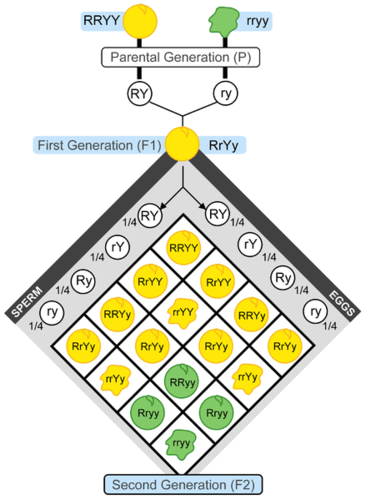
Figure 5.10.6 shows the outcome of a cross between plants that differ in seed colour (yellow or green) and seed form (shown here with a smooth round appearance or wrinkled appearance). The letters R, r, Y, and y represent genes for the characteristics Mendel was studying. Mendel didn’t know about genes, however, because genes would not be discovered until several decades later. This experiment demonstrates that, in the F2 generation, nine out of 16 were round yellow seeds, three out of 16 were wrinkled yellow seeds, three out of 16 were round green seeds, and one out of 16 was wrinkled green seeds.
F1 and F2 Generations
In this set of experiments, Mendel observed that plants in the F1 generation were all alike. All of them had yellow round seeds like one of the two parents. When the F1 generation plants self-pollinated, however, their offspring — the F2 generation — showed all possible combinations of the two characteristics. Some had green round seeds, for example, and some had yellow wrinkled seeds. These combinations of characteristics were not present in the F1 or P generations.
Law of Independent Assortment
Mendel repeated this experiment with other combinations of characteristics, such as flower colour and stem length. Each time, the results were the same as those shown in Figure 5.10.6. The results of Mendel's second set of experiments led to his second law. This is the law of independent assortment. It states that factors controlling different characteristics are inherited independently of each other.
Mendel's Legacy
You might think that Mendel's discoveries would have made a big impact on science as soon as he made them, but you would be wrong. Why? Because Mendel's work was largely ignored. Mendel was far ahead of his time, and he was working from a remote monastery. He had no reputation in the scientific community and had only published sparingly in the past. Additionally, he published this research in an obscure scientific journal. As a result, when Charles Darwin published his landmark book on evolution in 1869, although Mendel's work had been published just a few years earlier, Darwin was unaware of it. Consequently, Darwin knew nothing about Mendel's laws, and didn’t understand heredity. This made Darwin's arguments about evolution less convincing to many.
Then, in 1900, three different European scientists — Hugo de DeVries, Carl Correns, and Erich von Tschermak — arrived independently at Mendel's laws. All three had done experiments similar to Mendel's and come to the same conclusions that he had drawn several decades earlier. Only then was Mendel's work rediscovered, so that Mendel himself could be given the credit he was due. Although Mendel knew nothing about genes, which were discovered after his death, he is now considered the father of genetics.
5.10 Cultural Connection
Corn is the world's most produced crop. Canada produces 13,000-14,000 metric Kilo tonnes of corn annually, mostly in fields in Ontario, Quebec and Manitoba. Approximately 1.5 million hectares are devoted to this crop which is critically important for both humans and livestock as a food source. Despite these high numbers of output, Canada is still only 11th on the list of world corn producers, with USA, China and Brazil claiming the top three places. How did corn become such an important part of modern agriculture?
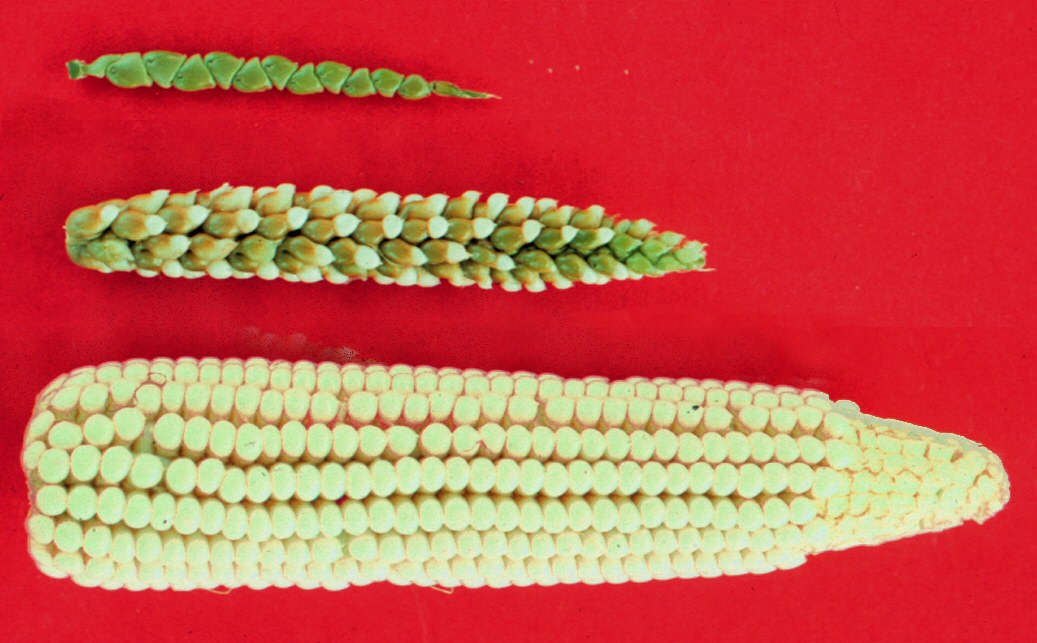
We didn't always have corn as we know it. Modern corn is descended from a type of grass called teosinte (Figure 5.10.7) native to Mesoamerica (southern part of North America). It is estimated that Indigenous people have been harvesting corn and corn ancestors for over 9000 years. Excavations of the Xihuatoxtla Shelter in southwestern Mexico revealed our earliest evidence of domesticated corn: maize remains on tools dating back 8,700 years.
Ancient Indigenous peoples of southern Mexico developed corn from grass plants using a process we now call selective breeding, also known as artificial selection. Teosinte doesn't resemble the corn we have today- it had only a few kernels individually encased on very hard shells, and yet today we have multiple varieties of corn with row upon row of bare kernels. This means that ancient agriculturalists among the Indigenous people of Mexico were intentionally cross-breeding strains of teosinte, and later, early maize to create plants which had more kernels, and reduced seed casings. Watch the TED Ed video in the Explore More section to see what other changes agriculturalists have made to modern-day corn.
5.10 Summary
- Mendel experimented with the inheritance of traits in pea plants at a time when the blending theory of inheritance was popular. This is the theory that offspring have a blend of the characteristics of their parents.
- Pea plants were good choices for this research, largely because they have several visible characteristics that exist in two different forms. By controlling pollination, Mendel was able to cross pea plants with different forms of the traits.
- In Mendel's first set of experiments, he experimented with just one characteristic at a time. The results of this set of experiments led to Mendel's first law of inheritance, called the law of segregation. This law states that there are two factors controlling a given characteristic, one of which dominates the other, and these factors separate and go to different gametes when a parent reproduces.
- In Mendel's second set of experiments, he experimented with two characteristics at a time. The results of this set of experiments led to Mendel's second law of inheritance, called the law of independent assortment. This law states that the factors controlling different characteristics are inherited independently of each other.
- Mendel's work was largely ignored during his own lifetime. However, when other researchers arrived at the same laws in 1900, Mendel's work was rediscovered, and he was given the credit he was due. He is now considered the father of genetics.
5.10 Review Questions
- Why were pea plants a good choice for Mendel's experiments?
-
- How did the outcome of Mendel's second set of experiments lead to his second law?
- Discuss the development of Mendel's legacy.
- If Mendel’s law of independent assortment was not correct, and characteristics were always inherited together, what types of offspring do you think would have been produced by crossing plants with yellow round seeds and green wrinkled seeds? Explain your answer.
5.10 Explore More
https://www.youtube.com/watch?v=Mehz7tCxjSE&feature=emb_logo
How Mendel's pea plants helped us understand genetics - Hortensia Jiménez Díaz, TED-Ed, 2013.
https://www.youtube.com/watch?v=ogc367xyzfk&feature=emb_logo
10 Strange Hybrid Fruits, Junkyboss, 2016.
https://www.youtube.com/watch?v=i6teBcfKpik
The history of the world according to corn - Chris A. Kniesly, TED-Ed, 2019.
Attributions
Figure 5.10.1
Purple sweet pea flower by unknown on Yana Ray on publicdomainpictures.net is used under a CC0 1.0 public domain dedication license (https://creativecommons.org/publicdomain/zero/1.0/deed.en).
Figure 5.10.2
Gregor_Mendel by unknown from National Institutes of Health, Health & Human Services on Wikimedia Commons is in the public domain (https://en.wikipedia.org/wiki/Public_domain).
Figure 5.10.3
Gregor Mendel in Lego by Alan on Flickr is used under a CC BY-NC-SA 2.0 (https://creativecommons.org/licenses/by-nc-sa/2.0/) license.
Figure 5.10.4
Mendels_peas by Mariana Ruiz [LadyofHats] on Wikimedia Commons is used under a CC0 1.0 public domain dedication license (https://creativecommons.org/publicdomain/zero/1.0/deed.en).
Figure 5.10.5
Mendel's first experiment with pea plants by CK-12 Foundation is used under a CC BY-NC 3.0 (https://creativecommons.org/licenses/by-nc/3.0/) license.
 ©CK-12 Foundation Licensed under
©CK-12 Foundation Licensed under ![]() • Terms of Use • Attribution
• Terms of Use • Attribution
Figure 5.10.6
Mendel's Second Experiment by by CK-12 Foundation is used under a CC BY-NC 3.0 (https://creativecommons.org/licenses/by-nc/3.0/) license.
 ©CK-12 Foundation Licensed under
©CK-12 Foundation Licensed under ![]() • Terms of Use • Attribution
• Terms of Use • Attribution
Figure 5.10.7
Maize-teosinte by John Doebley on Wikimedia Commons is used under a CC BY 3.0 (https://creativecommons.org/licenses/by/3.0/deed.en) license.
References
Brainard, J/ CK-12 Foundation. (2016). Figure 5 Mendel's first experiment [digital image]. In CK-12 College Human Biology (Section 5.9) [online Flexbook]. CK12.org. https://www.ck12.org/book/ck-12-human-biology/section/5.9/
Brainard, J/ CK-12 Foundation. (2016). Figure 6 Mendel's second experiment [digital image]. In CK-12 College Human Biology (Section 5.9) [online Flexbook]. CK12.org. https://www.ck12.org/book/ck-12-human-biology/section/5.9/
Junkyboss. (2016, March 31). 10 Strange hybrid fruits. YouTube. https://www.youtube.com/watch?v=ogc367xyzfk&feature=youtu.be
TED-Ed. (2013, March 12). How Mendel's pea plants helped us understand genetics - Hortensia Jiménez Díaz. YouTube. https://www.youtube.com/watch?v=Mehz7tCxjSE&feature=youtu.be
TED-Ed. (2019, November 26). The history of the world according to corn - Chris A. Kniesly. YouTube. https://www.youtube.com/watch?v=i6teBcfKpik&feature=youtu.be
Wikipedia contributors. (2020, June 1). Carl Correns. In Wikipedia. https://en.wikipedia.org/w/index.php?title=Carl_Correns&oldid=960172546
Wikipedia contributors. (2020, July 8). Charles Darwin. In Wikipedia. https://en.wikipedia.org/w/index.php?title=Charles_Darwin&oldid=966652322
Wikipedia contributors. (2020, March 9). Erich von Tschermak. In Wikipedia. https://en.wikipedia.org/w/index.php?title=Erich_von_Tschermak&oldid=944695823
Wikipedia contributors. (2020, July 7). Hugo de Vries. In Wikipedia. https://en.wikipedia.org/w/index.php?title=Hugo_de_Vries&oldid=966513671
Created by CK-12/Adapted by Christine Miller
As you read in the beginning of this chapter, new parents Samantha and Aki left their pediatrician’s office still unsure whether or not to vaccinate baby James. Dr. Rodriguez gave them a list of reputable sources where they could look up information about the safety of vaccines, including the Centers for Disease Control and Prevention (CDC). Samantha and Aki read that the consensus within the scientific community is that there is no link between vaccines and autism. They find a long list of studies published in peer-reviewed scientific journals that disprove any link. Additionally, some of the studies are “meta-analyses” that analyzed the findings from many individual studies. The new parents are reassured by the fact that many different researchers, using a large number of subjects in numerous well-controlled and well-reviewed studies, all came to the same conclusion.

Samantha also went back to the web page that originally scared her about the safety of vaccines. She found that the author was not a medical doctor or scientific researcher, but rather a self-proclaimed “child wellness expert.” He sold books and advertising on his site, some of which were related to claims of vaccine injury. She realized that he was both an unqualified and potentially biased source of information.
Samantha also realized that some of his arguments were based on correlations between autism and vaccines, but, as the saying goes, “correlation does not imply causation.” For instance, the recent rise in autism rates may have occurred during the same time period as an increase in the number of vaccines given in childhood, but Samantha could think of many other environmental and social factors that have also changed during this time period. There are just too many variables to come to the conclusion that vaccines, or anything else, are the cause of the rise in autism rates based on that type of argument alone. Also, she learned that the age of onset of autism symptoms happens to typically be around the time that the MMR vaccine is first given, so the apparent association in the timing may just be a coincidence.
Finally, Samantha came across news about a measles outbreak in Vancouver, British Columbia in the winter of 2019. Measles wasn’t just a disease of the past! She learned that measles and whooping cough, which had previously been rare thanks to widespread vaccinations, are now on the rise, and that people choosing not to vaccinate their children seems to be one of the contributing factors. She realized that it is important to vaccinate her baby against these diseases, not only to protect him from their potentially deadly effects, but also to protect others in the population.
In their reading, Samantha and Aki learn that scientists do not yet know the causes of autism, but they feels reassured by the abundance of data that disproves any link with vaccines. Both parents think that the potential benefits of protecting their baby’s health against deadly diseases outweighs any unsubstantiated claims about vaccines. They will be making an appointment to get baby James his shots soon.
Chapter 1 Summary
In this chapter, you learned about some of the same concepts that helped Samantha and Aki make an informed decision. Specifically:
- Science is a distinctive way of gaining knowledge about the natural world that is based on the use of evidence to logically test ideas. As such, science is a process, as well as a body of knowledge.
- A scientific theory, such as the germ theory of disease, is the highest level of explanation in science. A theory is a broad explanation for many phenomena that is widely accepted because it is supported by a great deal of evidence.
- The scientific investigation is the cornerstone of science as a process. A scientific investigation is a systematic approach to answering questions about the physical and natural world. An investigation may be observational or experimental.
- A scientific experiment is a type of scientific investigation in which the researcher manipulates variables under controlled conditions to test expected outcomes. Experiments are the gold standard for scientific investigations and can establish causation between variables.
- Nonexperimental scientific investigations such as observational studies and modeling may be undertaken when experiments are impractical, unethical, or impossible. Observational studies generally can establish correlation — but not causation — between variables.
- A pseudoscience, such as astrology, is a field that is presented as scientific but that does not adhere to scientific standards and methods. Other misuses of science include deliberate hoaxes, frauds, and fallacies made by researchers.
- Strict guidelines must be followed when using human subjects in scientific research. Among the most important protections is the requirement for informed consent.
Now that you know about the nature and process of science, you can apply these concepts in the next chapter to the study of human biology.
Chapter 1 Review
-
- Why does a good hypothesis have to be falsifiable?
- Name one scientific law.
- Name one scientific theory.
- Give an example of a scientific idea that was later discredited.
- A statistical measurement called a P-value is often used in science to determine whether or not a difference between two groups is actually significant or simply due to chance. A P-value of 0.03 means that there is a 3% chance that the difference is due to chance alone. Do you think a P-value of 0.03 would indicate that the difference is likely to be significant? Why or why not?
- Why is it important that scientists communicate their findings to others? How do they usually do this?
- What is a “control group” in science?
- In a scientific experiment, why is it important to only change one variable at a time?
- Which is the dependent variable – the variable that is manipulated or the variable that is being affected by the change?
- You see an ad for a “miracle supplement” called NQP3 that claims the supplement will reduce belly fat. They say it works by reducing the hormone cortisol and by providing your body with missing unspecified “nutrients”, but they do not cite any peer-reviewed clinical studies. They show photographs of three people who appear slimmer after taking the product. A board-certified plastic surgeon endorses the product on television. Answer the following questions about this product.
a. Do you think that because a doctor endorsed the product, it really works? Explain your answer.
b. What are two signs that these claims could actually be pseudoscience instead of true science?
c. Do you think the photographs are good evidence that the product works? Why or why not?
d. If you wanted to do a strong scientific study of whether this supplement does what it claims, what would you do? Be specific about the subjects, data collected, how you would control variables, and how you would analyze the data.
e. What are some ways that you would ensure that the subjects in your experiment in part d are treated ethically and according to human subjects protections regulations?
Attribution
Figure 1.8.1
[Photo of person sitting in front of personal computer] by Avel Chuklanov on Unsplash is used under the Unsplash License (https://unsplash.com/license).
A microorganism which causes disease.
An antibody, also known as an immunoglobulin, is a large, Y-shaped protein produced mainly by plasma cells that is used by the immune system to neutralize pathogens such as pathogenic bacteria and viruses.
Biological molecules that lower amount the energy required for a reaction to occur.
What Are You Made of?

Your entire body is made of cells and cells are made of molecules.If you look at your hand, what do you see? Of course, you see skin, which consists of cells. But what are skin cells made of? Like all living cells, they are made of matter. In fact, all things are made of matter. Matter is anything that takes up space and has mass. Matter, in turn, is made up of chemical substances. A chemical substance is matter that has a definite composition that is consistent throughout. A chemical substance may be either an element or a compound.
Elements and Atoms
An element is a pure substance. It cannot be broken down into other types of substances. Each element is made up of just one type of atom.
Structure of an Atom
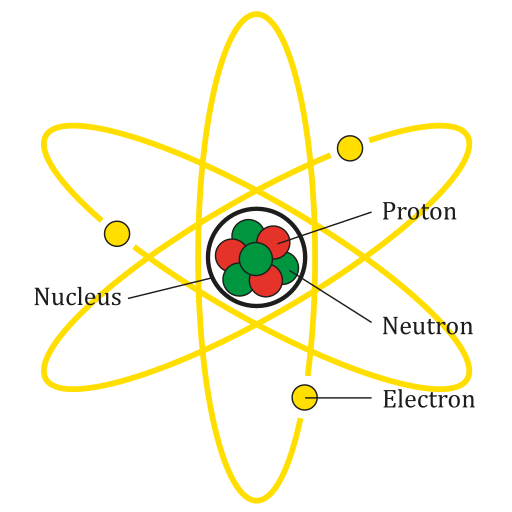
An atom is the smallest particle of an element that still has the properties of that element. Every substance is composed of atoms. Atoms are extremely small, typically about a ten-billionth of a metre in diametre. However, atoms do not have well-defined boundaries, as suggested by the atomic model shown below.
Every atom is composed of a central area — called the nucleus — and one or more subatomic particles called electrons, which move around the nucleus. The nucleus also consists of subatomic particles. It contains one or more protons and typically a similar number of neutrons. The number of protons in the nucleus determines the type of element an atom represents. An atom of hydrogen, for example, contains just one proton. Atoms of the same element may have different numbers of neutrons in the nucleus. Atoms of the same element with the same number of protons — but different numbers of neutrons — are called isotopes.
Protons have a positive electric charge and neutrons have no electric charge. Virtually all of an atom's mass is in the protons and neutrons in the nucleus. Electrons surrounding the nucleus have almost no mass, as well as a negative electric charge. If the number of protons and electrons in an atom are equal, then an atom is electrically neutral, because the positive and negative charges cancel each other out. If an atom has more or fewer electrons than protons, then it has an overall negative or positive charge, respectively, and it is called an ion.
The negatively-charged electrons of an atom are attracted to the positively-charged protons in the nucleus by a force called electromagnetic force, for which opposite charges attract. Electromagnetic force between protons in the nucleus causes these subatomic particles to repel each other, because they have the same charge. However, the protons and neutrons in the nucleus are attracted to each other by a different force, called nuclear force, which is usually stronger than the electromagnetic force. Nuclear force repels the positively-charged protons from each other.
Periodic Table of the Elements
There are almost 120 known elements. As you can see in the Periodic Table of the Elements shown below, the majority of elements are metals. Examples of metals are iron (Fe) and copper (Cu). Metals are shiny and good conductors of electricity and heat. Nonmetal elements are far fewer in number. They include hydrogen (H) and oxygen (O). They lack the properties of metals.
The periodic table of the elements arranges elements in groups based on their properties. The element most important to life is carbon (C). Find carbon in the table. What type of element is it: metal or nonmetal?
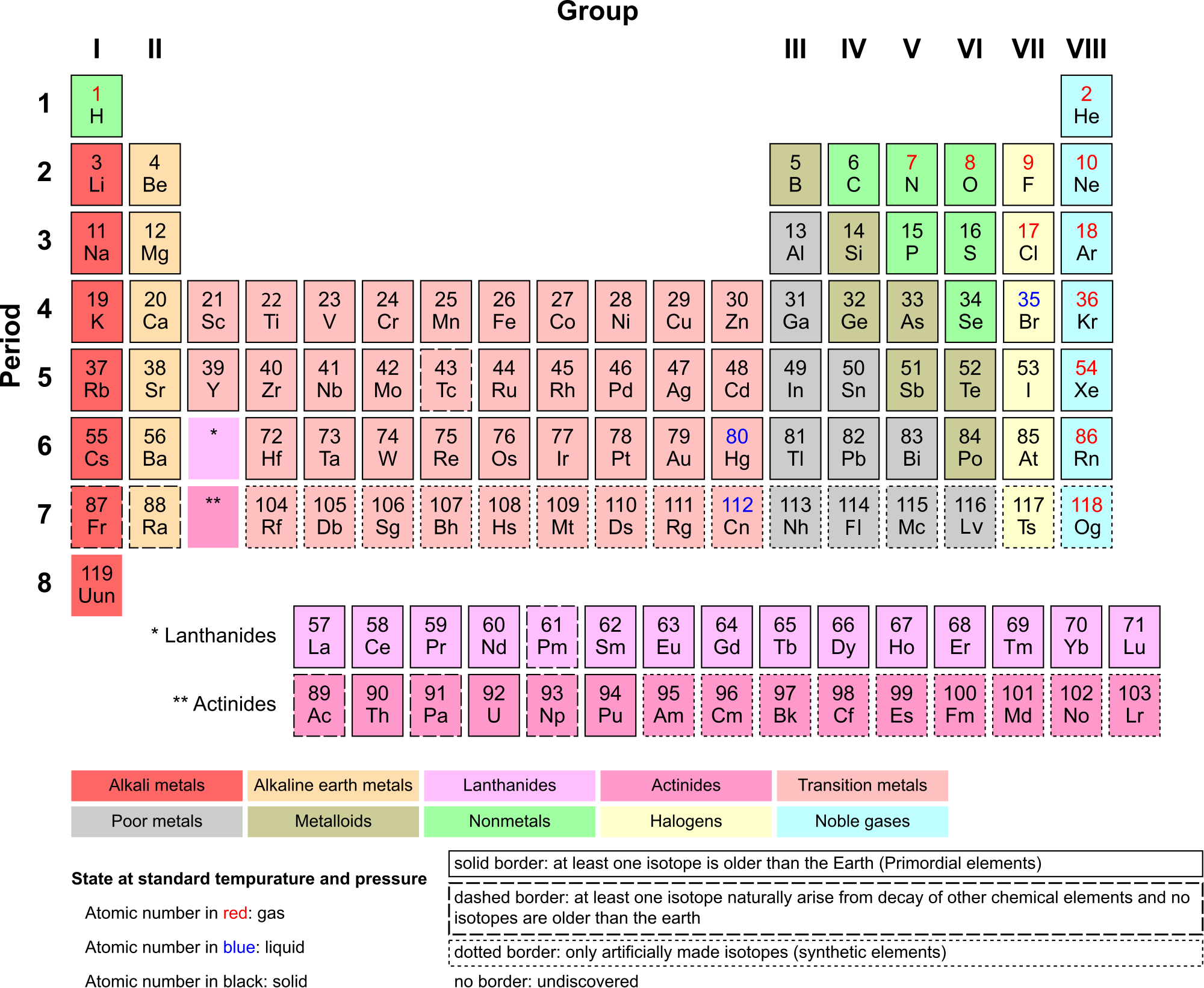
Compounds and Molecules
A compound is a unique substance that consists of two or more elements combined in fixed proportions. This means that the composition of a compound is always the same. The smallest particle of most compounds in living things is called a molecule.

Consider water as an example. A molecule of water always contains one atom of oxygen and two atoms of hydrogen. The composition of water is expressed by the chemical formula H2O. A model of a water molecule is shown in Figure 3.2.4.
What causes the atoms of a water molecule to “stick” together? The answer is chemical bonds. A chemical bond is a force that holds together the atoms of molecules. Bonds in molecules involve the sharing of electrons among atoms. New chemical bonds form when substances react with one another. A chemical reaction is a process that changes some chemical substances into others. A chemical reaction is needed to form a compound, and another chemical reaction is needed to separate the substances in that compound.
3.2 Summary
- All matter consists of chemical substances. A chemical substance has a definite composition which is consistent throughout. A chemical substance may be either an element or a compound.
- An element is a pure substance that cannot be broken down into other types of substances.
- An atom is the smallest particle of an element that still has the properties of that element. Atoms, in turn, are composed of subatomic particles, including negative electrons, positive protons, and neutral neutrons. The number of protons in an atom determines the element it represents.
- Atoms have equal numbers of electrons and protons, so they have no charge. Ions are atoms that have lost or gained electrons, and as a result have either a positive or negative charge. Atoms with the same number of protons — but different numbers of neutrons — are called isotopes.
- There are almost 120 known elements. The majority of elements are metals. A smaller number are nonmetals. The latter include carbon, hydrogen, and oxygen.
- A compound is a substance that consists of two or more elements in a unique composition. The smallest particle of a compound is called a molecule. Chemical bonds hold together the atoms of molecules. Compounds can form only in chemical reactions, and they can break down only in other chemical reactions.
3.2 Review Questions
-
- What is an element? Give three examples.
- Define compound. Explain how compounds form.
- Compare and contrast atoms and molecules.
- The compound called water can be broken down into its constituent elements by applying an electric current to it. What ratio of elements is produced in this process?
- Relate ions and isotopes to elements and atoms.
- What is the most important element to life?
- Iron oxide is often known as rust — the reddish substance you might find on corroded metal. The chemical formula for this type of iron oxide is Fe2O3. Answer the following questions about iron oxide and briefly explain each answer.
- Is iron oxide an element or a compound?
- Would one particle of iron oxide be considered a molecule or an atom?
- Describe the relative proportion of atoms in iron oxide.
- What causes the Fe and O to stick together in iron oxide?
- Is iron oxide made of metal atoms, metalloid atoms, nonmetal atoms, or a combination of any of these?
- 14C is an isotope of carbon used in the radiocarbon dating of organic material. The most common isotope of carbon is 12C. Do you think 14C and 12C have different numbers of neutrons or protons? Explain your answer.
- Explain why ions have a positive or negative charge.
- Name the three subatomic particles described in this section.
3.2 Explore More
https://www.youtube.com/watch?v=yQP4UJhNn0I&feature=emb_logo
Just how small is an atom? TED-Ed, 2012
Attributions
Figure 3.2.1
Man Sitting, by Gregory Culmer, on Unsplash, is used under the Unsplash license (https://unsplash.com/license).
Figure 3.2.2
Lithium Atom diagram, by AG Caesar, is used under a CC BY-SA 4.0 (https://creativecommons.org/licenses/by-sa/4.0/deed.en)
Figure 3.2.3
Periodic Table Armtuk3, by Armtuk, is used under a CC BY-SA 3.0 (https://creativecommons.org/licenses/by-sa/3.0/) license.
Figure 3.2.4
Water molecule, by Sakurambo, is released into the public domain (https://en.wikipedia.org/wiki/Public_domain).
References
TED-Ed. (2012, April 16). Just how small is an atom. YouTube. https://www.youtube.com/watch?v=yQP4UJhNn0I&feature=youtu.be
Image shows a diagram of the four stages of Meiosis I. In Prophase I, the nuclear envelope is fragmenting, the spindle fibers are forming, and the homologous pairs of chromosomes are undergoing crossing over, in which small segments of DNA are exchanged between homologous pairs. In metaphase I, the tetrads align at the equator. The alignment is termed Independent Alignment, since it is random for each tetrad which "side" the maternal or paternal chromosomes will end up on. In Anaphase I, the tetrads are seperated as dyads are pulled to opposite poles of the cell. In Telophase I the cleavage furrow forms, the dyads decondense and the nuclear envelope reforms as the spindle fibers fragment.
Image shows the four stages of Meiosis II: In Prophase II, the dyads condense, the nuclear envelope fragments and spindle fibers form. In Metaphase II, the dyads align at the center of the cell. In Anaphase II, the dyads are split pulled to opposite ends of the cell. In Telophase II the chromatids decondense, nuclear envelope reforms and spindle fibers fragment.
Image shows the process of crossing over. A pair of homologous chromosomes are side by side. They then overlap the ends of their structures and trades these sections, attaching some maternal DNA onto the paternal chromosome, and some paternal DNA onto the maternal chromosome. The result is that, within the homologous pair of chromosomes, each of the four pieces of DNA, destined to enter 4 separate cells, is now consists of a unique mix of genes.
Image illustrates how independent alignment greatly increases the genetic diversity among gametes produced. In a single cell undergoing Meiosis, independent alignment means that whether the paternal or maternal chromosome for each homologous pair ends up on the left or right is totally random, and is random for each pair of homologous chromosomes. In a cell which has 3 pairs of homologous chromosomes, there are 8 possible random alignments, which would each result in a different set of gametes being produced.
Image shows a sperm fertilizing an egg. The Sperm is much smaller than the egg.
A biomolecule consisting of carbon (C), hydrogen (H) and oxygen (O) atoms, usually with a hydrogen–oxygen atom ratio of 2:1. Complex carbohydrates are polymers made from monomers of simple carbohydrates, also termed monosaccharides.
A stored form of glucose used by plants.

All in the Family
This family photo (Figure 5.12.1) clearly illustrates an important point: children in a family resemble their parents and each other, but the children never look exactly the same, unless they are identical twins. Each of the daughters in the photo have inherited a unique combination of traits from the parents. In this concept, you will learn how this happens. It all begins with sex — sexual reproduction, that is.
Sexual Reproduction
Reproduction is the process by which organisms give rise to offspring. It is one of the defining characteristics of living things. Like many other organisms, human beings reproduce sexually. Sexual reproduction involves two parents. As you can see from Figure 5.12.2, in sexual reproduction, parents produce reproductive (sex) cells — called gametes — that unite to form an offspring. Gametes are haploid (or 1N) cells. This means they contain one copy of each chromosome in the nucleus. Gametes are produced by a type of cell division called meiosis, which is described in detail below. The process in which two gametes unite is called fertilization. The fertilized cell that results is referred to as a zygote. A zygote is a diploid (or 2N) cell, which means it contains two copies of each chromosome. Thus, it has twice the number of chromosomes as a gamete.
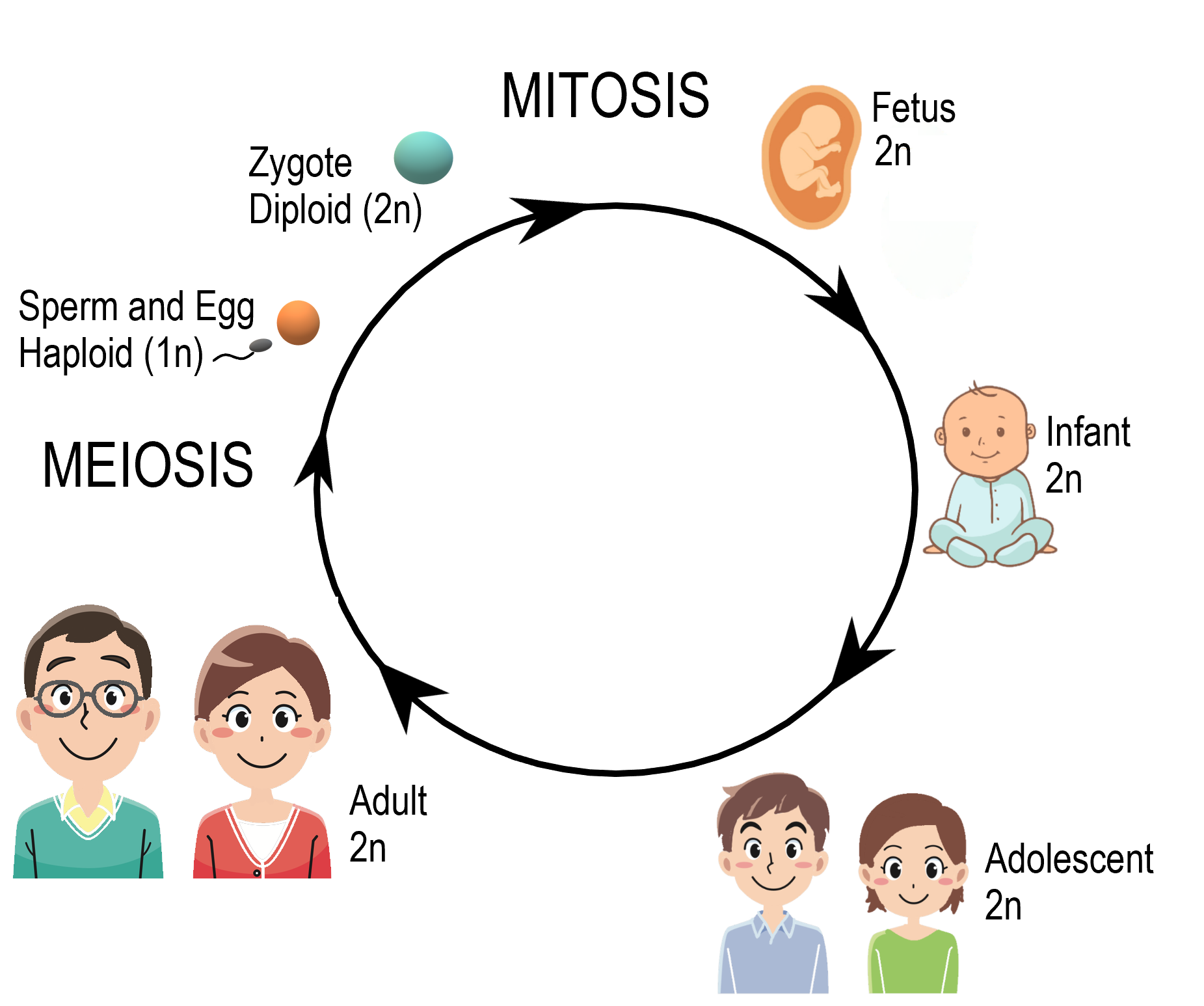
Meiosis
The process that produces haploid gametes is called meiosis. Meiosis is a type of cell division in which the number of chromosomes is reduced by half. It occurs only in certain special cells of an organism. During meiosis, homologous (paired) chromosomes separate, and four haploid cells form that have only one chromosome from each pair. The diagram (Figure 5.12.3) gives an overview of meiosis.
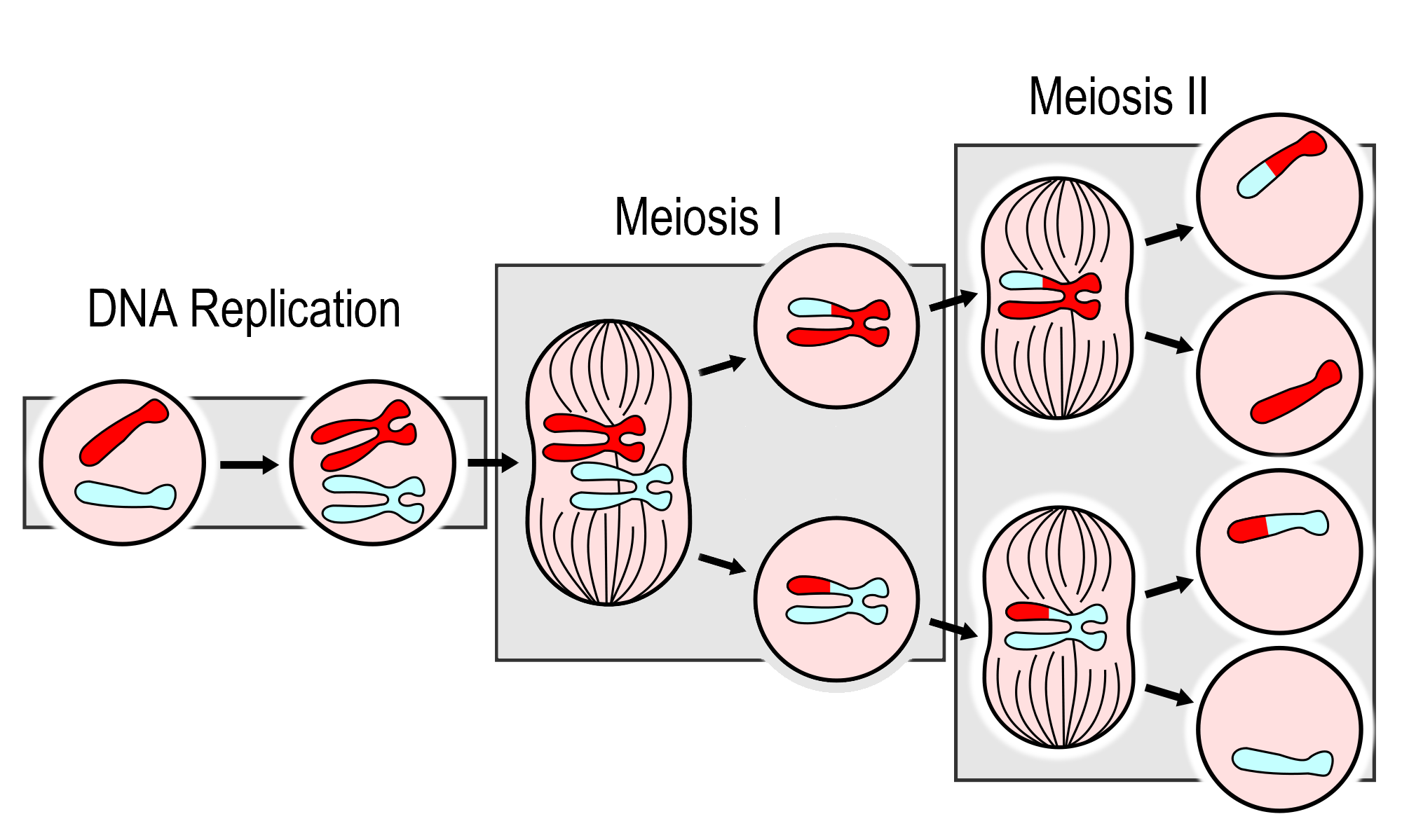
As you can see in the meiosis diagram, two cell divisions occur during the overall process, producing a total of four haploid cells from one parent cell. The two cell divisions are called meiosis I and meiosis II. Meiosis I begins after DNA replicates during interphase. Meiosis II follows meiosis I without DNA replicating again. Both meiosis I and meiosis II occur in four phases, called prophase, metaphase, anaphase, and telophase. You may recognize these four phases from mitosis, the division of the nucleus that takes place during routine cell division of eukaryotic cells.
Meiosis I- Increasing genetic variation
The phases of Meiosis I are:
- Prophase I: The nuclear envelope begins to break down, and the chromosomes condense. Centrioles start moving to opposite poles of the cell, and a spindle begins to form. Importantly, homologous chromosomes pair up, which is unique to prophase I. In prophase of mitosis and meiosis II, homologous chromosomes do not form pairs in this way. During prophase I, crossing-over occurs. The significance of crossing-over is discussed below.
- Metaphase I: Spindle fibres attach to the paired homologous chromosomes. The paired chromosomes line up along the equator of the cell, randomly aligning in a process called independent alignment. The significance of independent alignment is discussed below. This occurs only in metaphase I. In metaphase of mitosis and meiosis II, it is sister chromatids that line up along the equator of the cell.
- Anaphase I: Spindle fibres shorten, and the chromosomes of each homologous pair start to separate from each other. One chromosome of each pair moves toward one pole of the cell, and the other chromosome moves toward the opposite pole.
- Telophase I and Cytokinesis: The spindle breaks down, and new nuclear membranes form. The cytoplasm of the cell divides, and two haploid daughter cells result. The daughter cells each have a random assortment of chromosomes, with one from each homologous pair. Both daughter cells go on to meiosis II.

Meiosis II- Halfing the DNA
The phases of Meiosis II are:
- Prophase II: The nuclear envelope breaks down, and the spindle begins to form in each haploid daughter cell from meiosis I. The centrioles also start to separate.
- Metaphase II: Spindle fibres line up the sister chromatids of each chromosome along the equator of the cell.
- Anaphase II: Sister chromatids separate and move to opposite poles.
- Telophase II and Cytokinesis: The spindle breaks down, and new nuclear membranes form. The cytoplasm of each cell divides, and four haploid cells result. Each cell has a unique combination of chromosomes.
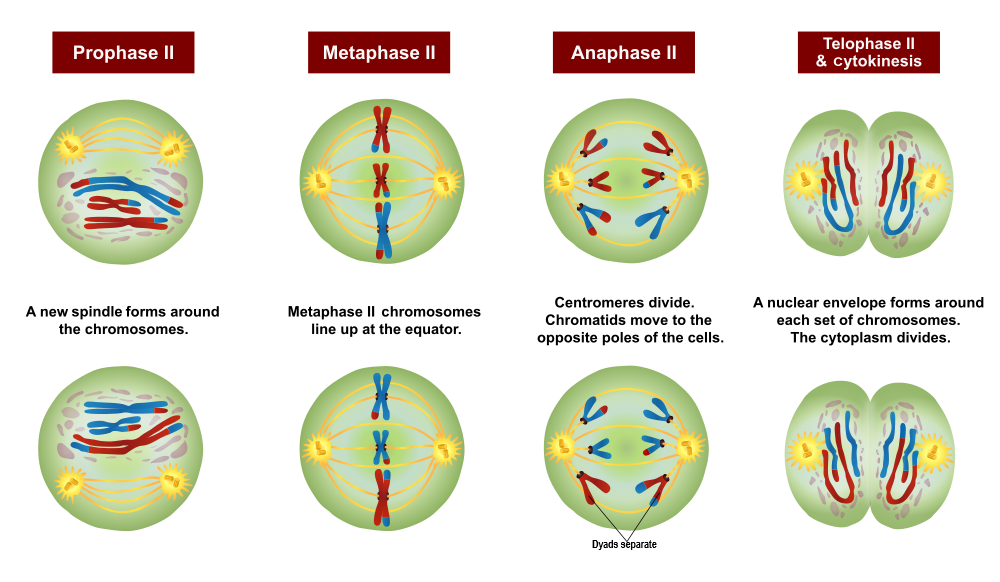
Sexual Reproduction and Genetic Variation
"It takes two to tango" might be a euphemism for sexual reproduction. Requiring two individuals to produce offspring, however, is also the main drawback of this way of reproducing, because it requires extra steps — and often a certain amount of luck — to successfully reproduce with a partner. On the other hand, sexual reproduction greatly increases the potential for genetic variation in offspring, which increases the likelihood that the resulting offspring will have genetic advantages. In fact, each offspring produced is almost guaranteed to be genetically unique, differing from both parents and from any other offspring. Sexual reproduction increases genetic variation in a number of ways:
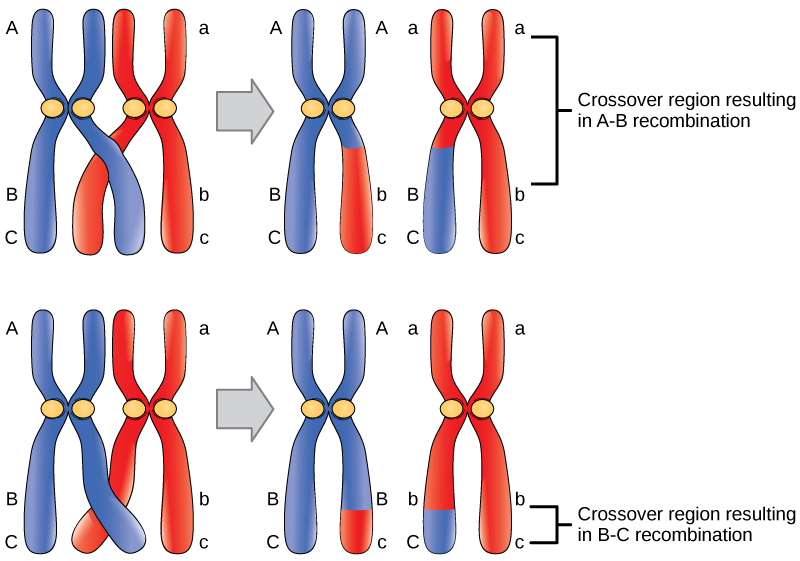
- When homologous chromosomes pair up during meiosis I, crossing-over can occur. Crossing-over is the exchange of genetic material between non-sister chromatids of homologous chromosomes. It results in new combinations of genes on each chromosome. This is called recombination. You can see how it happens in the figure to the right.
- When cells divide during meiosis, homologous chromosomes are randomly distributed to daughter cells, and different chromosomes segregate independently of each other. This is called independent alignment. It results in gametes that have unique combinations of chromosomes. You can see how it happens in Figure 5.12.7.
- In sexual reproduction, two gametes unite to produce an offspring. But which two of the millions of possible gametes will it be? This is a matter of chance, and it's obviously another source of genetic variation in offspring.
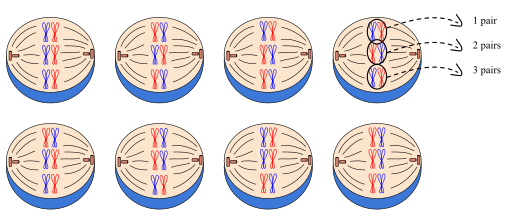
With all of this recombination of genes, there is a need for a new set of vocabulary. Remember, that sister chromatids are two identical pieces of DNA connected at a centromere. Once crossing over has occured, we can no longer call them sister chromatids since they are no longer identical; we term them dyads. In addition, once crossing over has occurred, the pair of homologous chromosomes can be referred to as tetrads.
All of these mechanisms — crossing over, independent assortment, and the random union of gametes — work together to result in an amazing range of potential genetic variation. Each human couple, for example, has the potential to produce more than 64 trillion genetically unique children. No wonder we are all different!
https://www.youtube.com/watch?v=VzDMG7ke69g
Meiosis (updated), Amoeba Sisters, 2017.
Gametogenesis
At the end of meiosis, four haploid cells have been produced, but the cells are not yet gametes. The cells need to develop before they become mature gametes capable of fertilization. The development of haploid cells into gametes is called gametogenesis. It differs between males and females.
- A gamete produced by a male is called a sperm, and the process that produces a mature sperm is called spermatogenesis. During this process, a sperm cell grows a tail and gains the ability to “swim,” like the human sperm cell shown in Figure 5.12.8.
- A gamete produced by a female is called anegg or ovum, and the process that produces a mature egg is called oogenesis, during which just one functional egg is produced. The other three haploid cells that result from meiosis are called polar bodies, and they disintegrate. The single egg is a very large cell, as you can see from the human egg also shown in Figure 5.12.8.
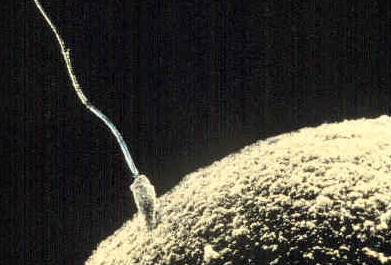
5.12 Summary
- In sexual reproduction, two parents produce gametes that unite in the process of fertilization to form a single-celled zygote. Gametes are haploid cells with one copy of each of the 23 chromosomes, and the zygote is a diploid cell with two copies of each of the 23 chromosomes.
- Meiosis is the type of cell division that produces four haploid daughter cells that may become gametes. Meiosis occurs in two stages, called meiosis I and meiosis II, each of which occurs in four phases (prophase, metaphase, anaphase, and telophase).
- Meiosis is followed by gametogenesis, the process during which the haploid daughter cells change into mature gametes. Males produce gametes called sperm in a process known as spermatogenesis, and females produce gametes called eggs in the process known as oogenesis.
- Sexual reproduction produces genetically unique offspring. Crossing-over, independent alignment, and the random union of gametes work together to result in an amazing range of potential genetic variation.
5.12 Review Questions
-
- Explain how sexual reproduction happens at the cellular level.
- Summarize what happens during Meiosis.
- Compare and contrast gametogenesis in males and females.
- Explain the mechanisms that increase genetic variation in the offspring produced by sexual reproduction.
- Why do gametes need to be haploid? What would happen to the chromosome number after fertilization if they were diploid?
- Describe one difference between Prophase I of Meiosis and Prophase of Mitosis.
- Do all of the chromosomes that you got from your mother go into one of your gametes? Why or why not?
5.12 Explore More
https://www.youtube.com/watch?v=qCLmR9-YY7o&feature=emb_logo
Meiosis: Where the Sex Starts - Crash Course Biology #13, CrashCourse, 2012.
https://www.youtube.com/watch?v=zrKdz93WlVk
Mitosis vs Meiosis Comparison, Amoeba Sisters, 2018.
Attributions
Figure 5.12.1
Family portrait by loly galina on Unsplash is used under the Unsplash License (https://unsplash.com/license).
Figure 5.12.2
Human Life Cycle by Christine Miller is used under a CC BY-NC-SA 4.0 (https://creativecommons.org/licenses/by-nc-sa/4.0/) license.
Figure 5.12.3
MajorEventsInMeiosis_variant_int by PatríciaR (internationalization) on Wikimedia Commons is used and adapted by Christine Miller. This image in the public domain. (Original image from NCBI; original vector version by Jakov.)
Figure 5.12.4
Meiosis 1/ Meiosis Stages by Ali Zifan on Wikimedia Commons is used and adapted by Christine Miller under a CC BY-SA 4.0 (https://creativecommons.org/licenses/by-sa/4.0) license.
Figure 5.12.5
Meiosis 2/ Meiosis Stages by Ali Zifan on Wikimedia Commons is used and adapted by Christine Miller under a CC BY-SA 4.0 (https://creativecommons.org/licenses/by-sa/4.0) license.
Figure 5.12.6
Crossover/ Figure 17 02 01 by CNX OpenStax on Wikimedia Commons is used under a CC BY 4.0 (https://creativecommons.org/licenses/by/4.0) license.
Figure 5.12.7
Independent_assortment by Mtian20 on Wikimedia Commons is used under a CC BY-SA 4.0 (https://creativecommons.org/licenses/by-sa/4.0) license.
Figure 5.12.8
sperm fertilizing egg by AndreaLaurel on Flickr is used under a CC BY 2.0 (https://creativecommons.org/licenses/by/2.0/) license.
References
Amoeba Sisters. (2017, July 11). Meiosis (updated). YouTube. https://www.youtube.com/watch?v=VzDMG7ke69g&feature=youtu.be
Amoeba Sisters. (2018, May 31). Mitosis vs meiosis comparison. YouTube. https://www.youtube.com/watch?v=zrKdz93WlVk&feature=youtu.be
CrashCourse, (2012, April 23). Meiosis: Where the sex starts - Crash Course Biology #13. YouTube. https://www.youtube.com/watch?v=qCLmR9-YY7o&feature=youtu.be
OpenStax CNX. (2016, May 27). Figure 1 Crossover may occur at different locations on the chromosome. In OpenStax, Biology (Section 17.2). http://cnx.org/contents/185cbf87-c72e-48f5-b51e-f14f21b5eabd@10.53.
Image shows a diagram of Killer T Cell funtion. An infected cell displays a pathogen antigen on an MHC. The Killer T Cell interacts with the MHC and in response produces perforin ( a protein that pokes holes in cell membranes) and granzymes (proteins that instruct a cell to carry out programmed cell death). The infected cell dies from the combination of these substances, and as it dies, so does the pathogen inside the infected cell. The Killer T Cell is free to move on and find and destroy other infected cells.
Image shows a diagram of the three stages of Translation. In Initiation, mRNA, a ribosome and tRNA carry methionine form a complex. In elongation, the ribosome moves along the mRNA, as tRNA with matching anticodons bring and then drop off the corresponding amino acids. In termination, a stop codon is reached, and the entire complex disassembles, and releases the newly synthesize polypeptide.
Image shows an example of a Punnett Square. In this example, a mother and father who are both heterozygous for eye colour result in four children of whom: 25% have blue eyes, 75% have brown eyes, 25% are homozygous dominant (with brown eyes being the dominant trait), 25% are homozygous recessive, and 50% are heterozygous
Created by CK-12 Foundation/Adapted by Christine Miller

Doing the ‘Fly
The swimmer in the Figure 13.3.1 photo is doing the butterfly stroke, a swimming style that requires the swimmer to carefully control his breathing so it is coordinated with his swimming movements. Breathing is the process of moving air into and out of the lungs, which are the organs in which gas exchange takes place between the atmosphere and the body. Breathing is also called ventilation, and it is one of two parts of the life-sustaining process of respiration. The other part is gas exchange. Before you can understand how breathing is controlled, you need to know how breathing occurs.
How Breathing Occurs
Breathing is a two-step process that includes drawing air into the lungs, or inhaling, and letting air out of the lungs, or exhaling. Both processes are illustrated in Figure 13.3.2.
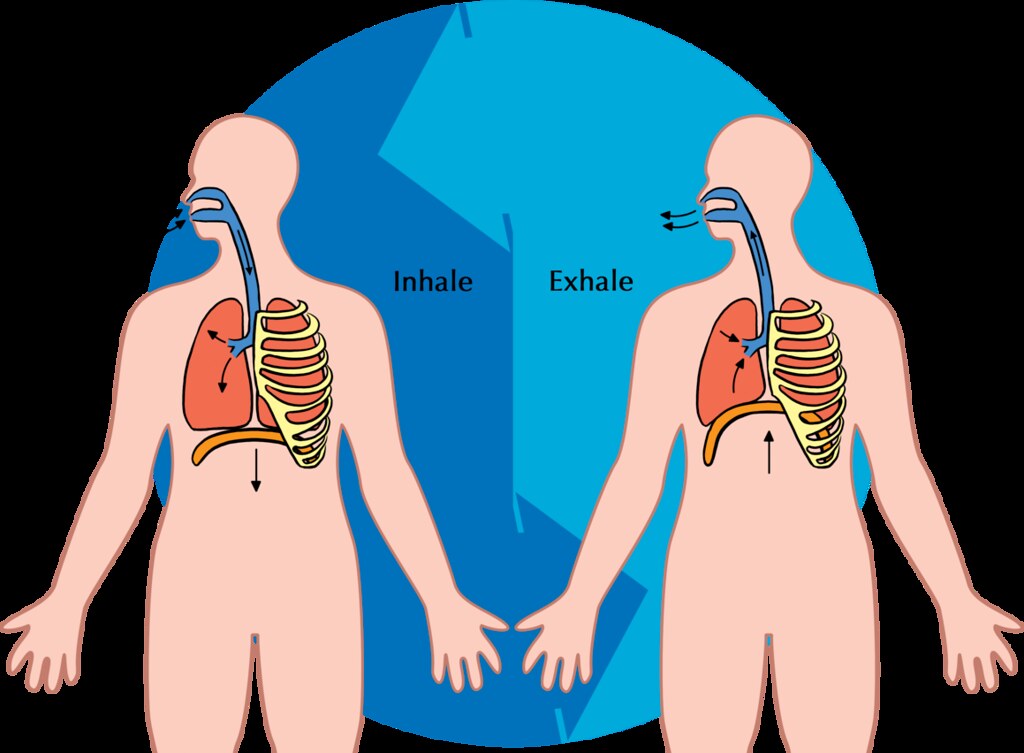
Inhaling
Inhaling is an active process that results mainly from contraction of a muscle called the diaphragm, shown in Figure 13.3.2. The diaphragm is a large, dome-shaped muscle below the lungs that separates the thoracic (chest) and abdominal cavities. When the diaphragm contracts it moves down causing the thoracic cavity to expand, and the contents of the abdomen to be pushed downward. Other muscles — such as intercostal muscles between the ribs — also contribute to the process of inhalation, especially when inhalation is forced, as when taking a deep breath. These muscles help increase thoracic volume by expanding the ribs outward. The increase in thoracic volume creates a decrease in thoracic air pressure. With the chest expanded, there is lower air pressure inside the lungs than outside the body, so outside air flows into the lungs via the respiratory tract according the the pressure gradient (high pressure flows to lower pressure).
Exhaling
Exhaling involves the opposite series of events. The diaphragm relaxes, so it moves upward and decreases the volume of the thorax. Air pressure inside the lungs increases, so it is higher than the air pressure outside the lungs. Exhalation, unlike inhalation, is typically a passive process that occurs mainly due to the elasticity of the lungs. With the change in air pressure, the lungs contract to their pre-inflated size, forcing out the air they contain in the process. Air flows out of the lungs, similar to the way air rushes out of a balloon when it is released. If exhalation is forced, internal intercostal and abdominal muscles may help move the air out of the lungs.
Control of Breathing
Breathing is one of the few vital bodily functions that can be controlled consciously, as well as unconsciously. Think about using your breath to blow up a balloon. You take a long, deep breath, and then you exhale the air as forcibly as you can into the balloon. Both the inhalation and exhalation are consciously controlled.
Conscious Control of Breathing
You can control your breathing by holding your breath, slowing your breathing, or hyperventilating, which is breathing more quickly and shallowly than necessary. You can also exhale or inhale more forcefully or deeply than usual. Conscious control of breathing is common in many activities besides blowing up balloons, including swimming, speech training, singing, playing many different musical instruments (Figure 13.3.3), and doing yoga, to name just a few.

There are limits on the conscious control of breathing. For example, it is not possible for a healthy person to voluntarily stop breathing indefinitely. Before long, there is an irrepressible urge to breathe. If you were able to stop breathing for a long enough time, you would lose consciousness. The same thing would happen if you were to hyperventilate for too long. Once you lose consciousness so you can no longer exert conscious control over your breathing, involuntary control of breathing takes over.
Unconscious Control of Breathing
Unconscious breathing is controlled by respiratory centers in the medulla and pons of the brainstem (see Figure 13.3.4). The respiratory centers automatically and continuously regulate the rate of breathing based on the body’s needs. These are determined mainly by blood acidity, or pH. When you exercise, for example, carbon dioxide levels increase in the blood, because of increased cellular respiration by muscle cells. The carbon dioxide reacts with water in the blood to produce carbonic acid, making the blood more acidic, so pH falls. The drop in pH is detected by chemoreceptors in the medulla. Blood levels of oxygen and carbon dioxide, in addition to pH, are also detected by chemoreceptors in major arteries, which send the “data” to the respiratory centers. The latter respond by sending nerve impulses to the diaphragm, “telling” it to contract more quickly so the rate of breathing speeds up. With faster breathing, more carbon dioxide is released into the air from the blood, and blood pH returns to the normal range.
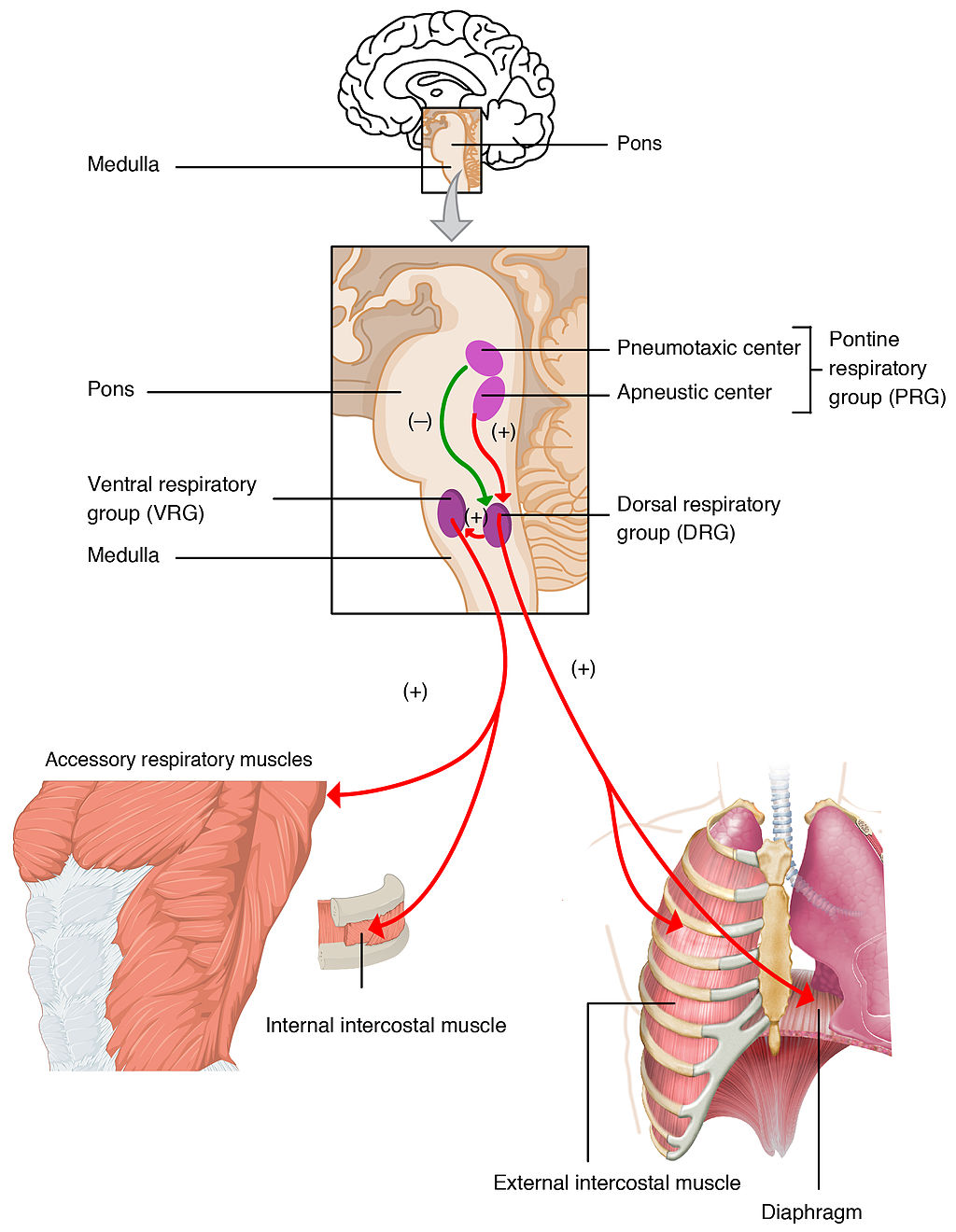
The opposite events occur when the level of carbon dioxide in the blood becomes too low and blood pH rises. This may occur with involuntary hyperventilation, which can happen in panic attacks, episodes of severe pain, asthma attacks, and many other situations. When you hyperventilate, you blow off a lot of carbon dioxide, leading to a drop in blood levels of carbon dioxide. The blood becomes more basic (alkaline), causing its pH to rise.
Nasal vs. Mouth Breathing
Nasal breathing is breathing through the nose rather than the mouth, and it is generally considered to be superior to mouth breathing. The hair-lined nasal passages do a better job of filtering particles out of the air before it moves deeper into the respiratory tract. The nasal passages are also better at warming and moistening the air, so nasal breathing is especially advantageous in the winter when the air is cold and dry. In addition, the smaller diameter of the nasal passages creates greater pressure in the lungs during exhalation. This slows the emptying of the lungs, giving them more time to extract oxygen from the air.
Feature: Myth vs. Reality
Drowning is defined as respiratory impairment from being in or under a liquid. It is further classified according to its outcome into: death, ongoing health problems, or no ongoing health problems (full recovery). Four hundred Canadians die annually from drowning, and drowning is one of the leading causes of death in children under the age of five. There are some potentially dangerous myths about drowning, and knowing what they are might save your life or the life of a loved one, especially a child.
| Myth | Reality |
|---|---|
| "People drown when they aspirate water into their lungs." | Generally, in the early stages of drowning, very little water enters the lungs. A small amount of water entering the trachea causes a muscular spasm in the larynx that seals the airway and prevents the passage of water into the lungs. This spasm is likely to last until unconsciousness occurs. |
| "You can tell when someone is drowning because they will shout for help and wave their arms to attract attention." | The muscular spasm that seals the airway prevents the passage of air, as well as water, so a person who is drowning is unable to shout or call for help. In addition, instinctive reactions that occur in the final minute or so before a drowning person sinks under the water may look similar to calm, safe behavior. The head is likely to be low in the water, tilted back, with the mouth open. The person may have uncontrolled movements of the arms and legs, but they are unlikely to be visible above the water. |
| "It is too late to save a person who is unconscious in the water." | An unconscious person rescued with an airway still sealed from the muscular spasm of the larynx stands a good chance of full recovery if they start receiving CPR within minutes. Without water in the lungs, CPR is much more effective. Even if cardiac arrest has occurred so the heart is no longer beating, there is still a chance of recovery. The longer the brain goes without oxygen, however, the more likely brain cells are to die. Brain death is likely after about six minutes without oxygen, except in exceptional circumstances, such as young people drowning in very cold water. There are examples of children surviving, apparently without lasting ill effects, for as long as an hour in cold water. Rescuers retrieving a child from cold water should attempt resuscitation even after a protracted period of immersion. |
| "If someone is drowning, you should start administering CPR immediately, even before you try to get the person out of the water." | Removing a drowning person from the water is the first priority, because CPR is ineffective in the water. The goal should be to bring the person to stable ground as quickly as possible and then to start CPR. |
| "You are unlikely to drown unless you are in water over your head." | Depending on circumstances, people have drowned in as little as 30 mm (about 1 ½ in.) of water. Inebriated people or those under the influence of drugs, for example, have been known to have drowned in puddles. Hundreds of children have drowned in the water in toilets, bathtubs, basins, showers, pails, and buckets (see Figure 13.3.5). |

13.3 Summary
- Breathing, or ventilation, is the two-step process of drawing air into the lungs (inhaling) and letting air out of the lungs (exhaling). Inhalation is an active process that results mainly from contraction of a muscle called the diaphragm. Exhalation is typically a passive process that occurs mainly due to the elasticity of the lungs when the diaphragm relaxes.
- Breathing is one of the few vital bodily functions that can be controlled consciously, as well as unconsciously. Conscious control of breathing is common in many activities, including swimming and singing. There are limits on the conscious control of breathing, however. If you try to hold your breath, for example, you will soon have an irrepressible urge to breathe.
- Unconscious breathing is controlled by respiratory centers in the medulla and pons of the brainstem. They respond to variations in blood pH by either increasing or decreasing the rate of breathing as needed to return the pH level to the normal range.
- Nasal breathing is generally considered to be superior to mouth breathing because it does a better job of filtering, warming, and moistening incoming air. It also results in slower emptying of the lungs, which allows more oxygen to be extracted from the air.
- Drowning is a major cause of death in Canada, in particular in children under the age of five. It is important to supervise small children when they are playing in, around, or with water.
13.3 Review Questions
- Define breathing.
-
- Give examples of activities in which breathing is consciously controlled.
- Explain how unconscious breathing is controlled.
- Young children sometimes threaten to hold their breath until they get something they want. Why is this an idle threat?
- Why is nasal breathing generally considered superior to mouth breathing?
- Give one example of a situation that would cause blood pH to rise excessively. Explain why this occurs.
13.3 Explore More
https://www.youtube.com/watch?v=Kl4cU9sG_08
How breathing works - Nirvair Kaur, TED-Ed, 2012.
https://www.youtube.com/watch?v=yDtKBXOEsoM
How do ventilators work? - Alex Gendler, TED-Ed, 2020.
https://www.youtube.com/watch?v=XFnGhrC_3Gs&feature=emb_logo
How I held my breath for 17 minutes | David Blaine, TED, 2010.
https://www.youtube.com/watch?v=Vca6DyFqt4c&feature=emb_logo
The Ultimate Relaxation Technique: How To Practice Diaphragmatic Breathing For Beginners, Kai Simon, 2015.
Attributions
Figure 13.3.1
US_Marines_butterfly_stroke by Cpl. Jasper Schwartz from U.S. Marine Corps on Wikimedia Commons is in the public domain (https://en.wikipedia.org/wiki/Public_domain).
Figure 13.3.2
Inhale Exhale/Breathing cycle by Siyavula Education on Flickr is used under a CC BY 2.0 (https://creativecommons.org/licenses/by/2.0/) license.
Figure 13.3.3
Trumpet/ Frenchmen Street [photo] by Morgan Petroski on Unsplash is used under the Unsplash License (https://unsplash.com/license).
Figure 13.3.4
Respiratory_Centers_of_the_Brain by OpenStax College on Wikimedia Commons is used under a CC BY 3.0 (https://creativecommons.org/licenses/by/3.0) license.
Figure 13.3.5
Lily & Ava in the Kiddie Pool by mob mob on Flickr is used under a CC BY-NC 2.0 (https://creativecommons.org/licenses/by-nc/2.0/) license.
References
Betts, J. G., Young, K.A., Wise, J.A., Johnson, E., Poe, B., Kruse, D.H., Korol, O., Johnson, J.E., Womble, M., DeSaix, P. (2013, June 19). Figure 22.20 Respiratory centers of the brain [digital image]. In Anatomy and Physiology (Section 22.3). OpenStax. https://openstax.org/books/anatomy-and-physiology/pages/22-3-the-process-of-breathing
Kai Simon. (2015, January 11). The ultimate relaxation technique: How to practice diaphragmatic breathing for beginners. YouTube. https://www.youtube.com/watch?v=Vca6DyFqt4c&feature=youtu.be
TED. (2010, January 19). How I held my breath for 17 minutes | David Blaine. YouTube. https://www.youtube.com/watch?v=XFnGhrC_3Gs&feature=youtu.be
TED-Ed. (2012, October 4). How breathing works - Nirvair Kaur. YouTube. https://www.youtube.com/watch?v=Kl4cU9sG_08&feature=youtu.be
TED-Ed. (2020, May 21). How do ventilators work? - Alex Gendler. YouTube. https://www.youtube.com/watch?v=yDtKBXOEsoM&feature=youtu.be
Image shows a diagram of the implications of an x-linked recessive trait when carried by the mother. If a carrier mother has children with an unaffected father, 25% of their children can be expected to be unaffected males, 25% affected males, 25% unaffected females, and 25% carrier females.

